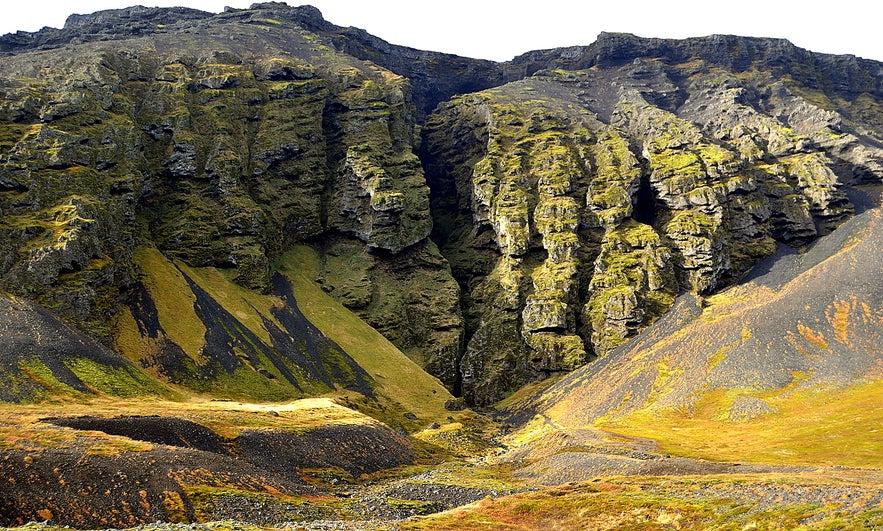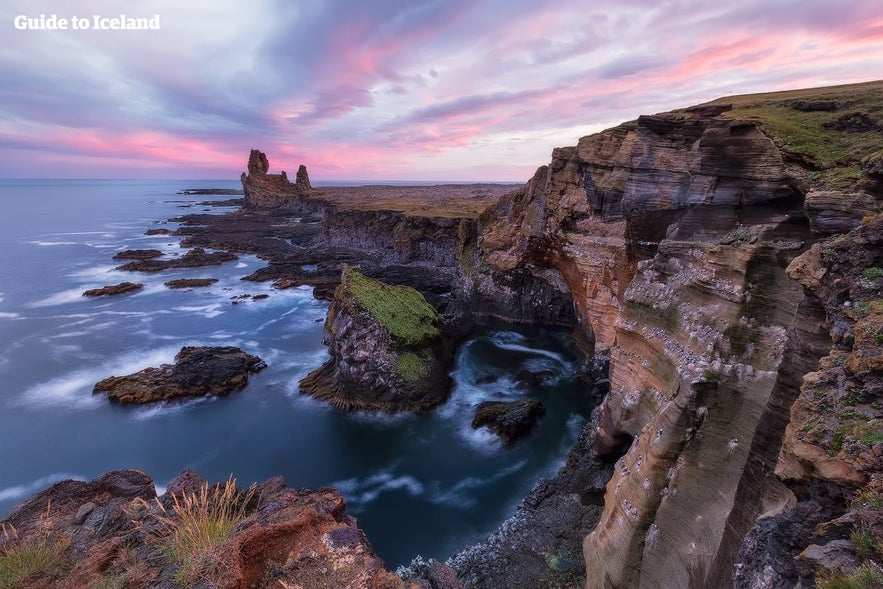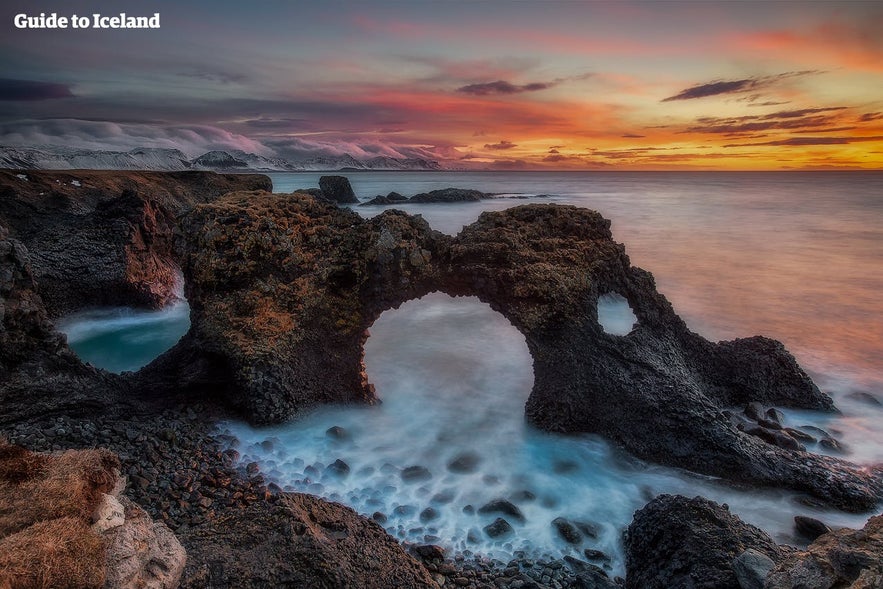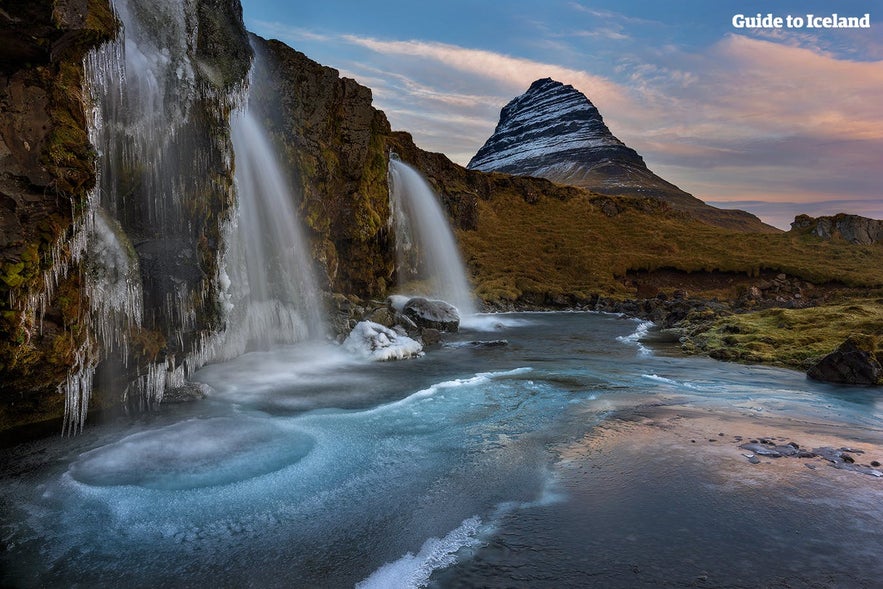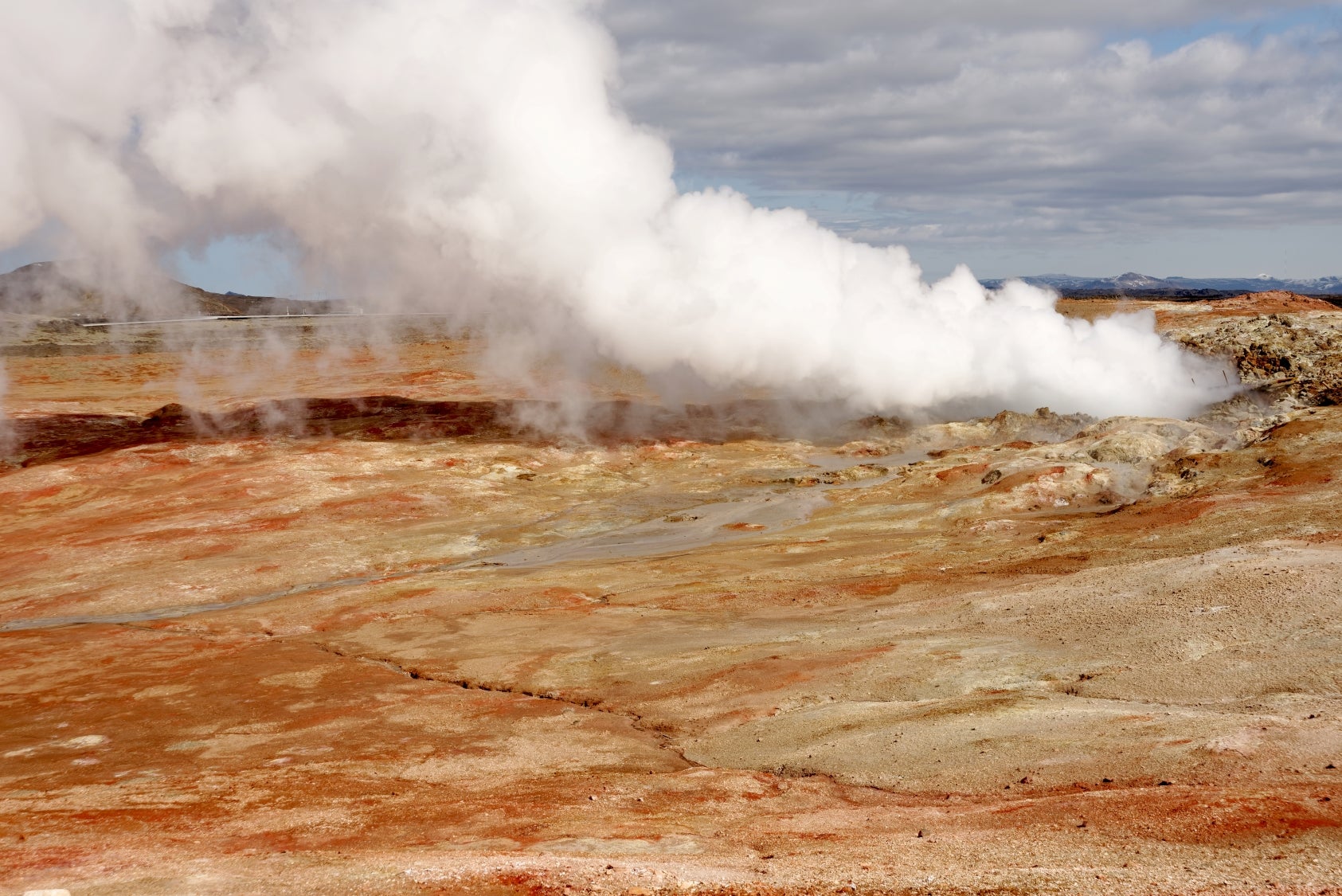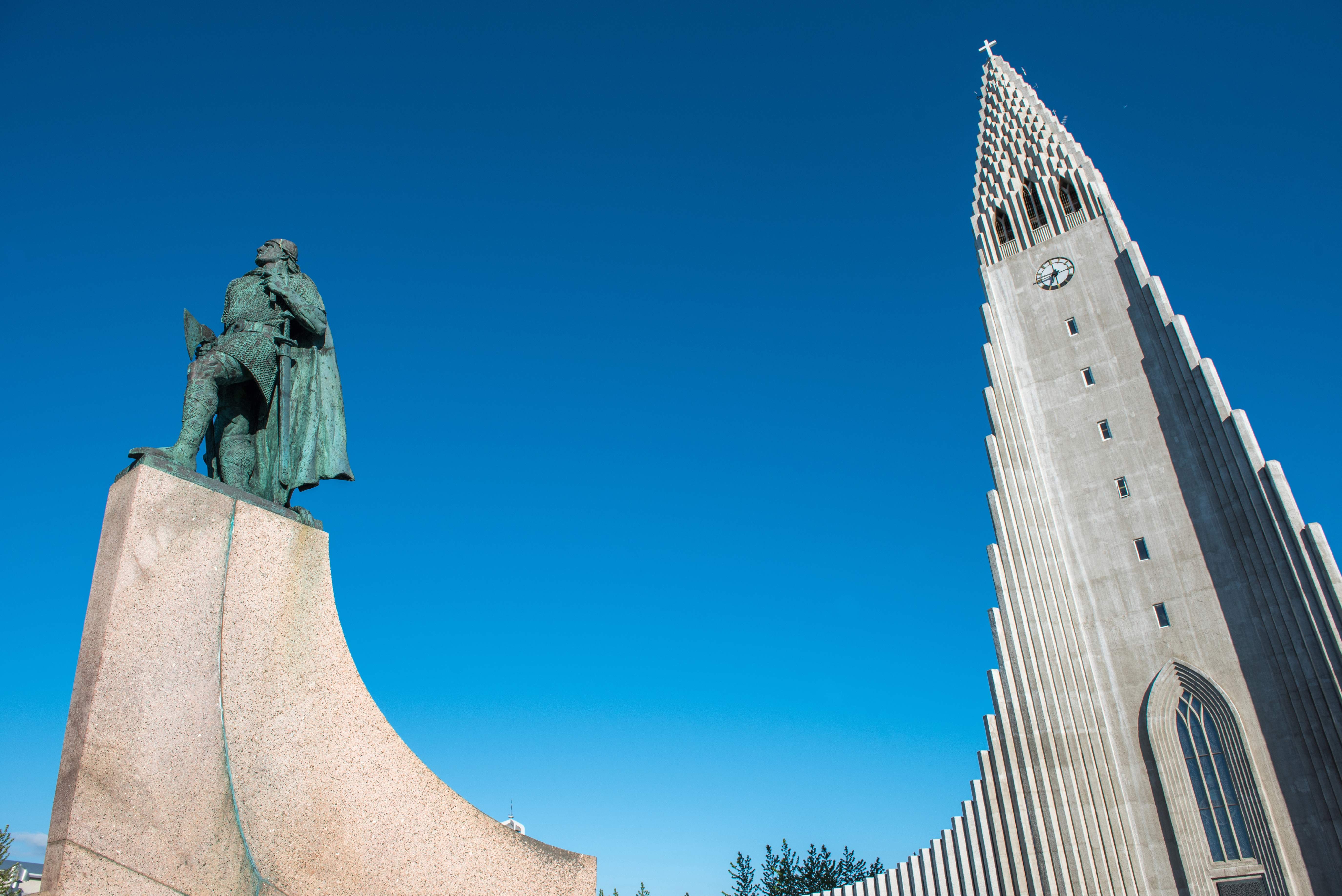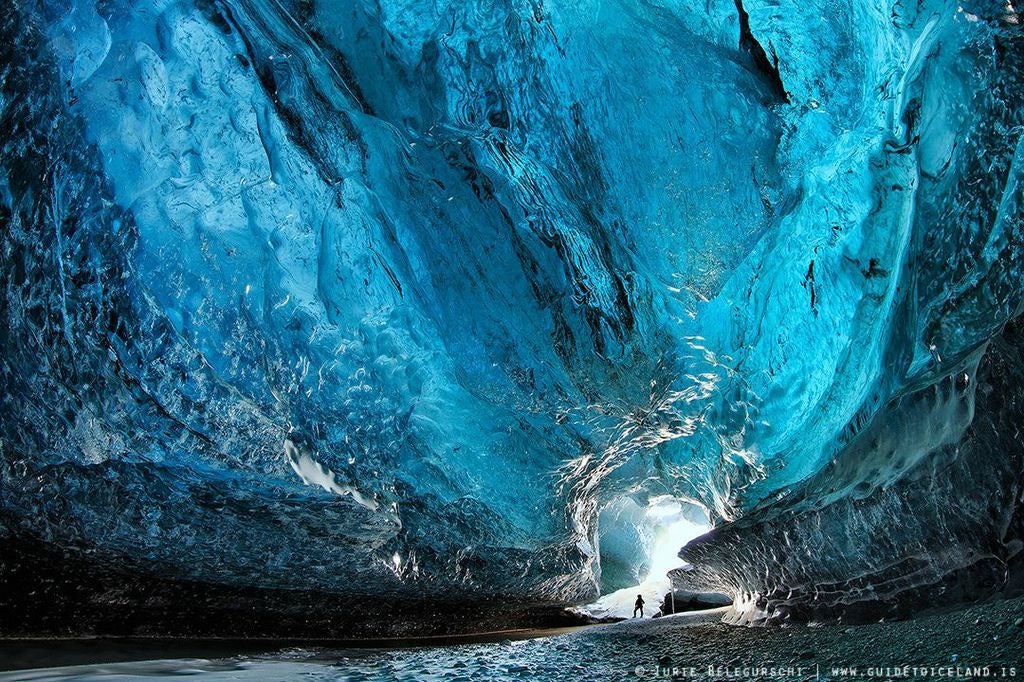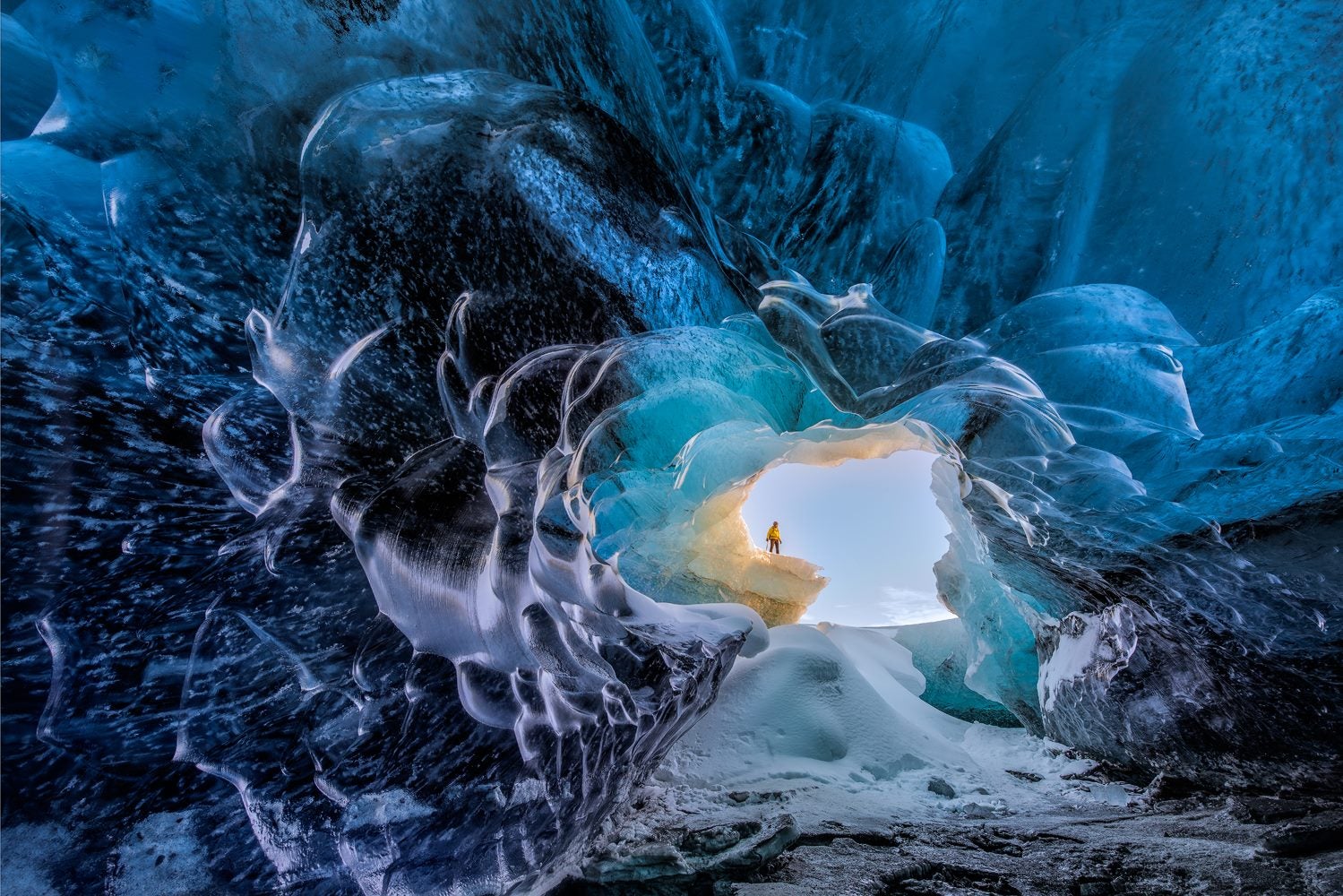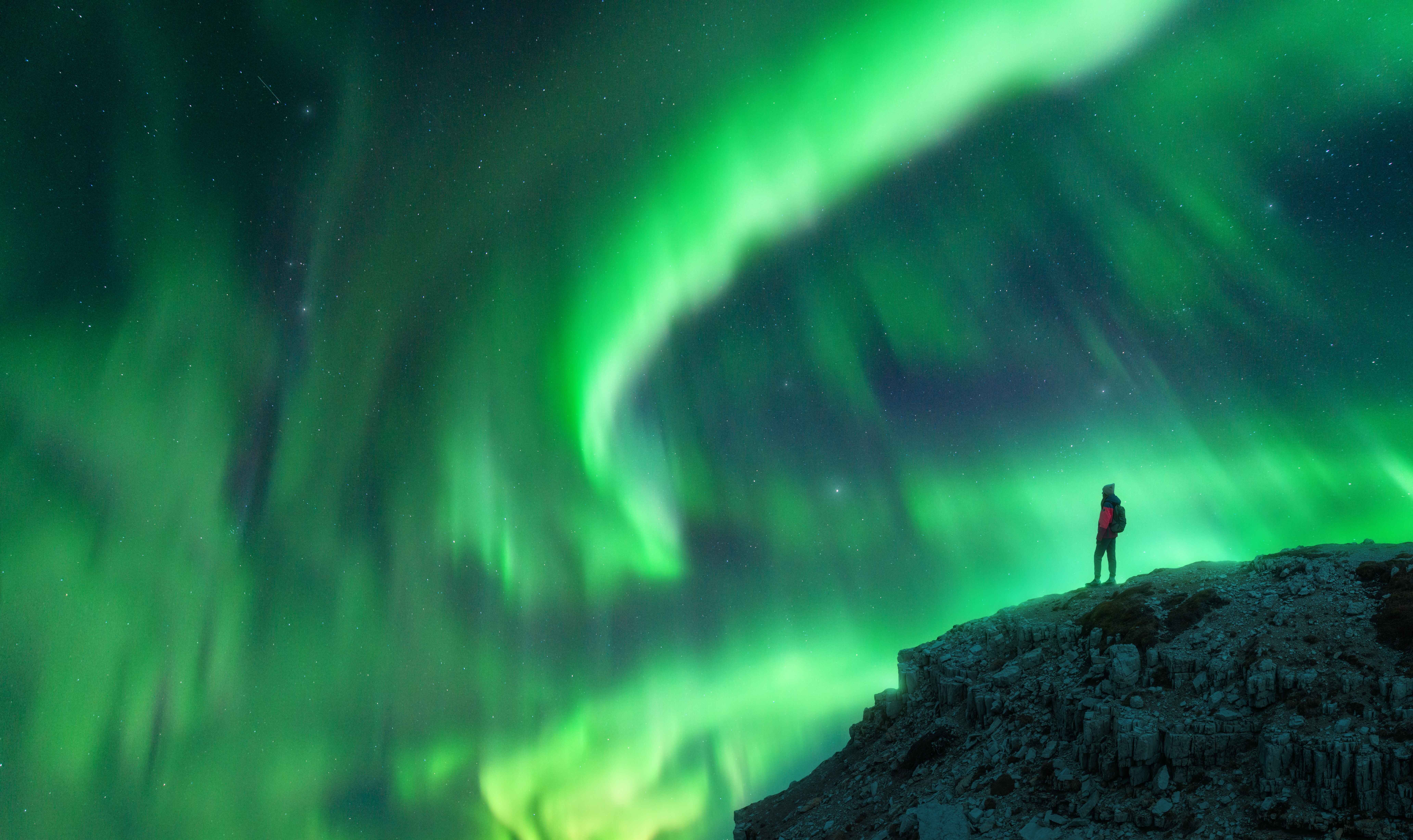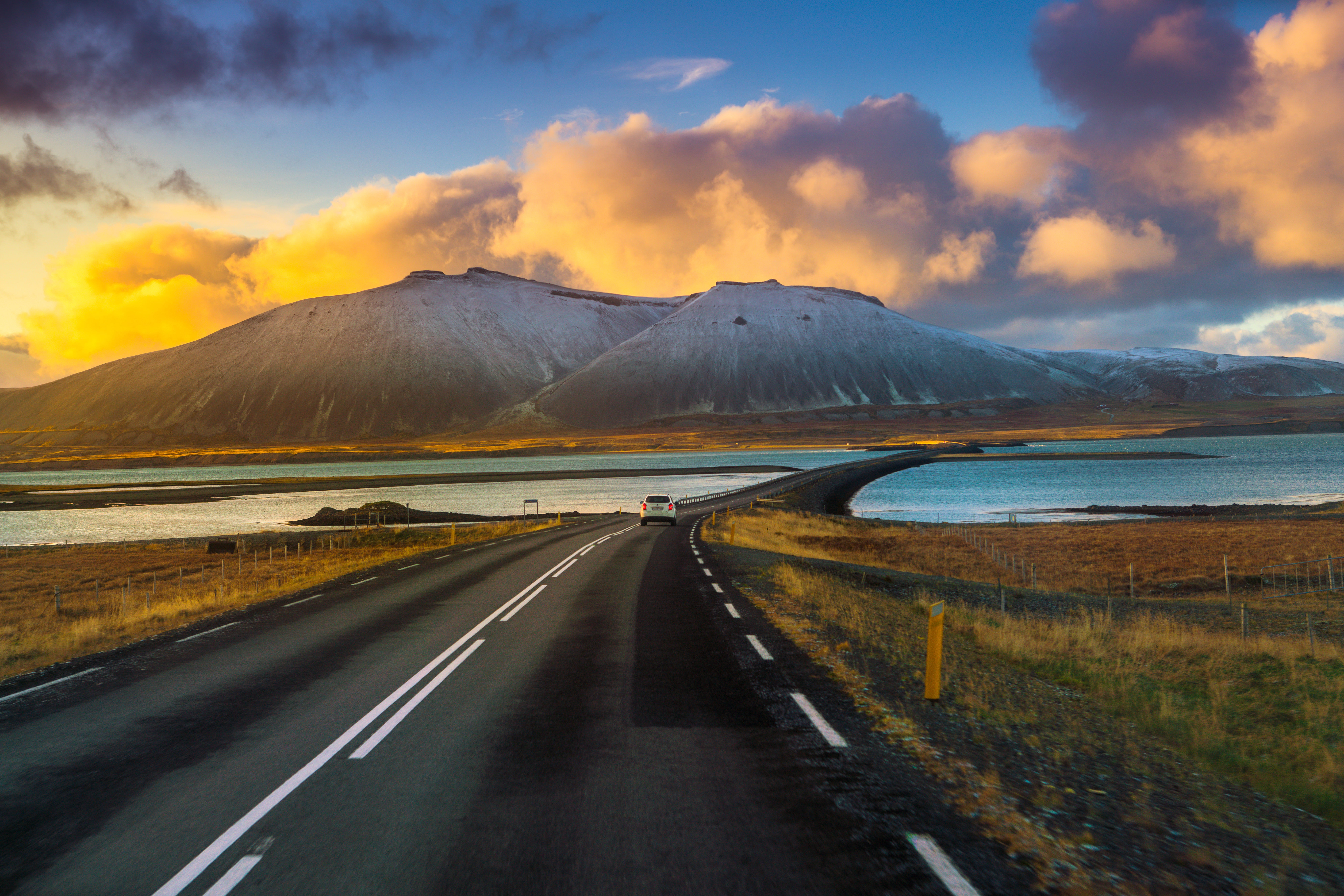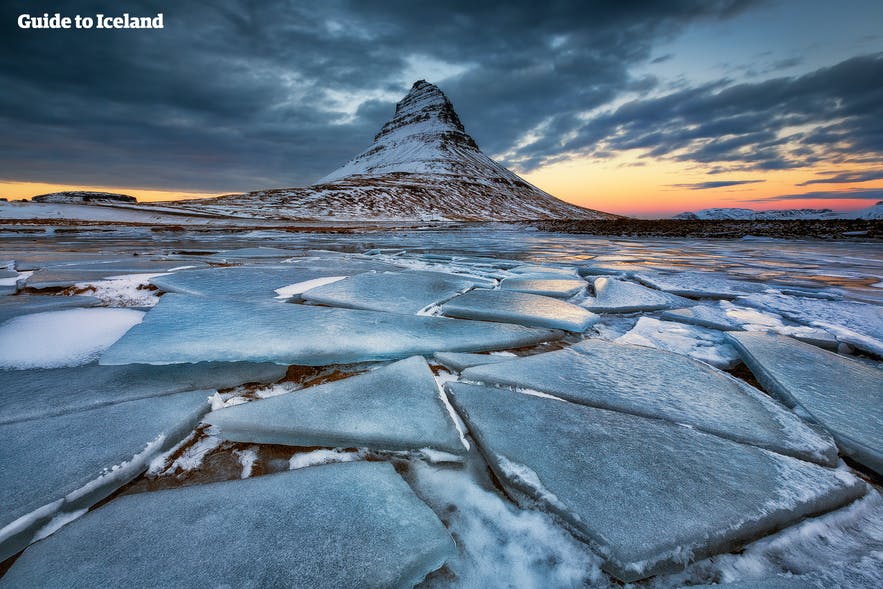
What are the top things to see on the Snaefellsnes Peninsula, and why is it called “Iceland in Miniature”? Explore this stunning West Iceland region and discover the 17 best stops in and around Snaefellsjokull National Park.
The Snaefellsnes Peninsula in West Iceland packs an incredible range of scenery into one unforgettable stretch of coastline, so much so that it's often called "Iceland in Miniature."
Here you’ll find the iconic Snaefellsjokull Glacier Volcano towering over the landscape, alongside wave-battered cliffs, black-sand shores, and rugged rock formations rising straight from the Atlantic.
Since the Snaefellsnes Peninsula is only a two-hour drive (about 120 miles or 200 kilometers) from Reykjavik, you can easily explore all this on self-driving tours with a rental car. There are also many Snaefellsnes tours to choose from that will help you discover the region, either by yourself or through guided multi-day tours.
Why You Can Trust Our Content
Guide to Iceland is the most trusted travel platform in Iceland, helping millions of visitors each year. All our content is written and reviewed by local experts who are deeply familiar with Iceland. You can count on us for accurate, up-to-date, and trustworthy travel advice.
Driving along the Snaefellsnes Peninsula offers stunning views in every direction. From calm fishing villages to charming towns, it's easy to find your perfect accommodation in Snaefellsnes. Whether you're visiting on a day trip from Reykjavik or staying longer, use this list to plan your perfect itinerary with the top things to do on the Snaefellsnes Peninsula!
Key Takeaways
-
The peninsula offers a variety of natural wonders such as the black sand beach of Djupalonssandur, the basalt cliffs of Londrangar, and the picturesque Kirkjufell Mountain.
-
Visitors can explore quaint fishing villages like Arnarstapi and Hellnar, which provide insights into Icelandic culture and history.
-
The area is excellent for wildlife enthusiasts, offering opportunities for puffin tours and whale watching in Breidafjordur Bay.
-
To fully appreciate the peninsula's offerings, consider joining guided tours that cover major attractions, including Snaefellsjokull National Park and Kirkjufell Mountain.
17. Raudfeldsgja Gorge
Raudafeldsgja Gorge is a beautiful gorge with a small waterfall hidden inside. You can reach it in summer, but you’ll have to climb through the river and up some smaller waterfalls (a rope is provided). You will get wet and cold, so only attempt this if you are wearing warm and waterproof clothes and have dry clothes to change into as soon as you come back.
It's also not necessary to hike the entire way to the waterfall — simply go as far as you feel comfortable with and come back! The hike up to the canyon from the parking lot is beautiful, and you'll have stunning views over Faxafloi Bay toward Reykjavik.
The gorge also has a rich history. It got its name from a character in the Icelandic sagas, Rauðfeldur. Legend has it that he and his brother, Sölvi, were pushed into the ravine by their half-uncle Bárður Snæfellsás, leading to their deaths.
This tragic event occurred because the brothers had pushed Bárður's daughter onto an iceberg, leading him to believe her dead. In reality, she survived, but her iceberg drifted to Greenland. When she returned home, it was unfortunately too late.
16. Oxl Observation Point and Dreplakolludys Cairn
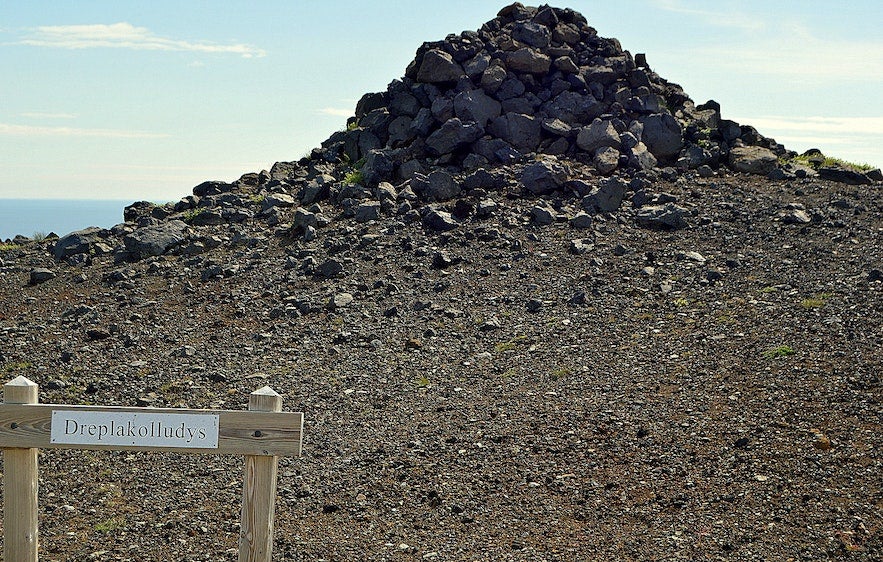
If you're interested in learning about Iceland’s dark history, consider including the Oxl Observation Point and the Dreplakolludys Cairn on your Snaefellsnes Peninsula itinerary.
As you drive along Route 574 along the edge of the Snaefellsnes Peninsula, you'll pass by a farmstead called Oxl, which sits under the Axlarhyrna Mountain. You'll find a great observation point with views of the Snaefellsjokull Glacier, but you'll also discover an information sign covering the horrific story of the area.
In the 16th century, the Oxl Farmstead was the home of Björn Pétursson, better known as Axlar-Björn, Iceland's only serial killer. Björn preyed on travelers, offering them shelter before taking their lives and disposing of the bodies in the nearby Iglutjorn Pond.
He was caught in 1596 and sentenced to death. He was charged with the murder of 18 people, though the actual number may well have been higher.
Because of his evil, people were afraid that he would come back from the dead after his execution. He was supposedly tortured and eventually dismembered to prevent this. His body was buried in three different locations on the Snaefellsnes Peninsula, and only one of these locations still exists. It's called Dreplakolludys Crain, located near the village of Hellnar.
15. Songhellir Cave
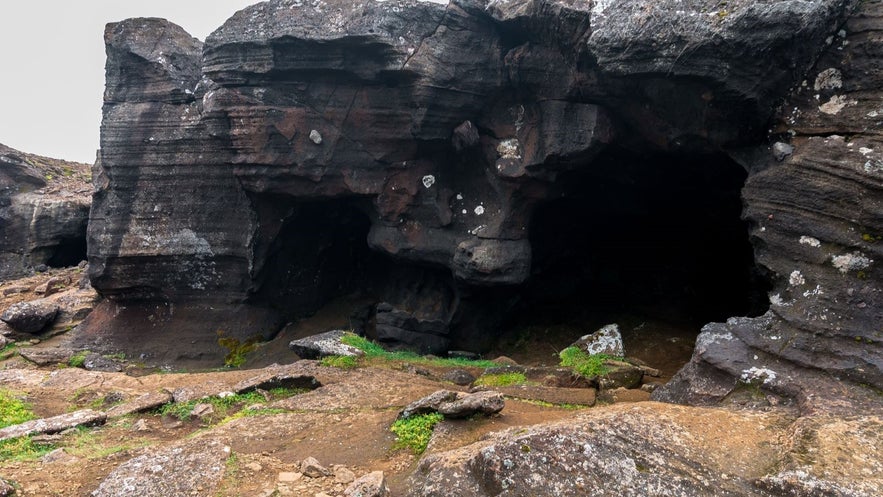 If you have a four-wheel-drive rental car and are exploring Iceland in summer, you can visit the Songhellir Cave. The translation "Singing cave" is appropriate because of its echo and acoustic quality. Locals also believe it once sheltered Bárður Snæfellsá, the fabled half-man, half-giant guardian of the peninsula in the 9th century.
If you have a four-wheel-drive rental car and are exploring Iceland in summer, you can visit the Songhellir Cave. The translation "Singing cave" is appropriate because of its echo and acoustic quality. Locals also believe it once sheltered Bárður Snæfellsá, the fabled half-man, half-giant guardian of the peninsula in the 9th century.
To visit the Songhellir Cave, you'll have to take the F570 mountain road. Then, there's only a short walk up to the cave. It's clearly marked, so you shouldn't have trouble finding it. You'll be able to enjoy beautiful views over the surrounding area, and remember to test out the cave's echo!
Additionally, you'll see a lot of carvings inside the cave, including the names Eggert Ólafsson and Bjarni Palsson. They are believed to be the first people to reach the summit of the Snaefellsjokull Glacier in 1754, but they're best known for their book detailing their travels around Iceland between 1752 and 1757.
It's a valuable source of information about daily life in Iceland during the 18th century. Published in English under the title Travels in Iceland: Performed by Order of His Danish Majesty, it's worth a read if you want to learn about Icelandic history and culture.
14. Irskrabrunnur & Gufuskalavor Archaeological Site
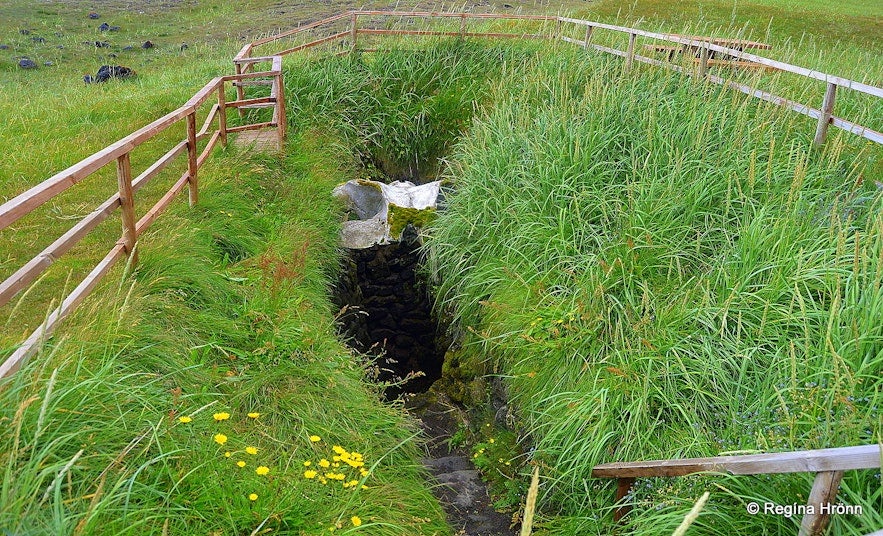
One of the more unique locations to visit on the Snaefellsnes Peninsula is the Gufuskalar and Irskrabrunnur Archaeological Site. It's easily accessible, just by the main road on the tip of the peninsula.
Irskrabrunnur means "Irish Well," and that's exactly what it is. The well served as a source of drinking water for nearby inhabitants and travelers, but it was lost for a long time, buried by sand.
However, locals told stories about a grand well in the area, which they rediscovered in the mid-19th century before losing it again. Archaeologists formally excavated it in 1989.
Today, it has clear markings and fencing for safety. You can walk down the 16 steps to the bottom, though the well has long dried up. You can also see a massive whale bone that hangs above the well's opening.
The Irskrabrunnur name refers to the "papar," Irish monks who supposedly lived in Iceland before the Norse settlement, though archaeological evidence has not confirmed this. It's more likely that the well is from the Middle Ages, made by sailors from the nearby Gufuskalar Fishing Station, but this is still unclear. Nonetheless, the well is a grand construction!
The Gufuskalar Fishing Station is worth a stop during your visit, as there are interesting ruins in the area dating back to the 14th and 15th centuries. By the shore, you can even see grooves in the rocks formed by the keels of rowboats.
A few meters away, you can stop by Irskrabyrgi or "the Shelter of the Irish," a stacking of lava rocks likely made to shelter livestock.
13. Bjarnarfoss Waterfall
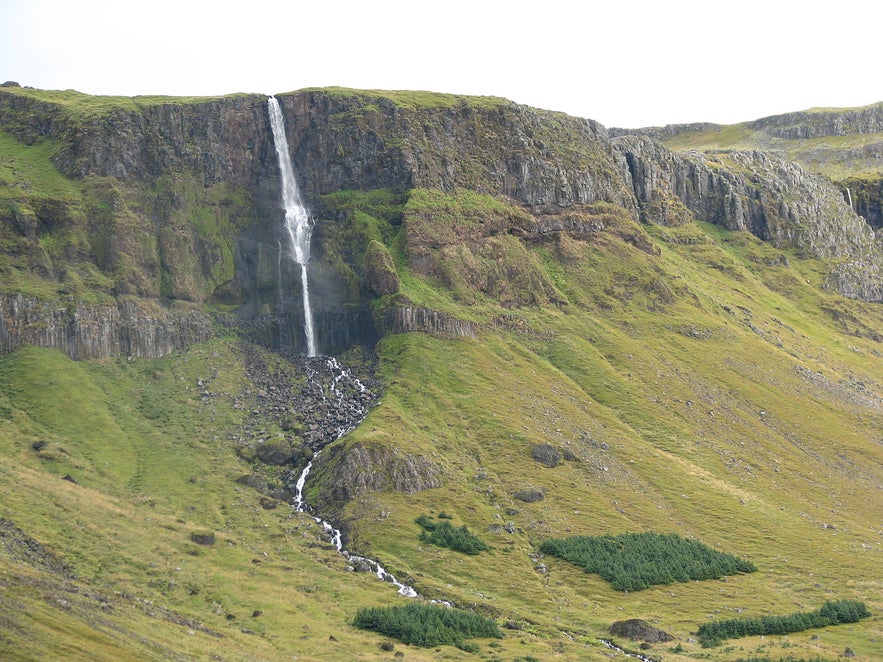 Photo from Wikimedia, Creative Commons, by Bromr
Photo from Wikimedia, Creative Commons, by Bromr
The beautiful Bjarnarfoss Waterfall cascades down a mountainside on the southern coast of the Snaefellsnes Peninsula. When driving along the main road, you will see the watery mist from the waterfall for a long time before it appears.
The Bjarnarfoss Waterfall is 262 feet (80 meters) tall, and the walk to it is both easy and picturesque, though it can be difficult to go all the way up to it in winter. Nearby, there is a parking lot and a comfortable resting area where you can recharge and admire its beauty, making it a great stop to include in your travels.
The waterfall is also said to hide a treasure. According to legend, a wealthy farmer named Bjarni refused to provide shelter for a passing traveler. The traveler cursed him, causing Bjarni's livestock and crops to die. This led to Bjarni going mad and throwing all of his wealth into the waterfall, which has yet to be found.
12. Gerduberg Basalt Cliffs
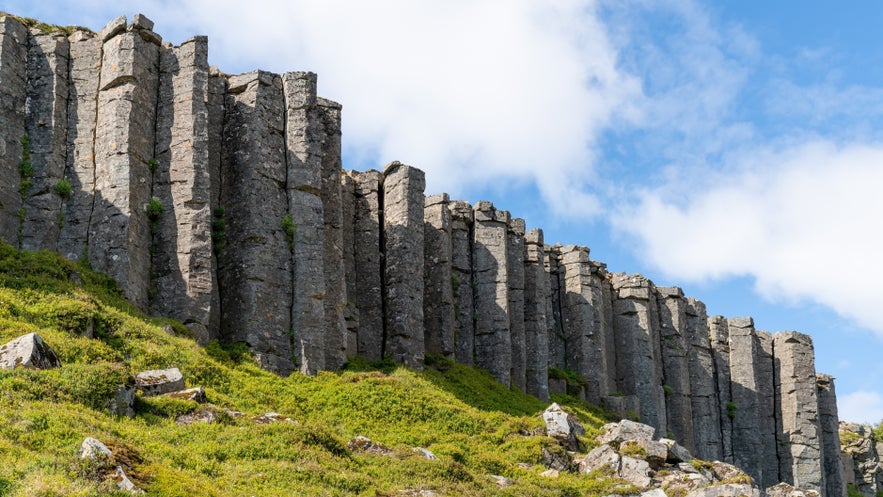
The dramatic Gerduberg Cliffs are one of the longest rows of basalt cliffs in Iceland. They formed due to volcanic activity and the slow cooling of lava and run along the main road for over half a mile (1 kilometer).
These geological formations consist of symmetrical columnar basalt between 23 and 46 feet tall (7 and 14 meters). You can easily access them from the main road. From the parking lot, you can either walk up to the top of the Gerduberg Cliffs or the bottom. The walk is pretty easy, though the last part is very steep.
We recommend taking the time to walk up to them to appreciate their impressive size. It's one of the more beautiful basalt cliffs in Iceland.
11. Eldborg Crater
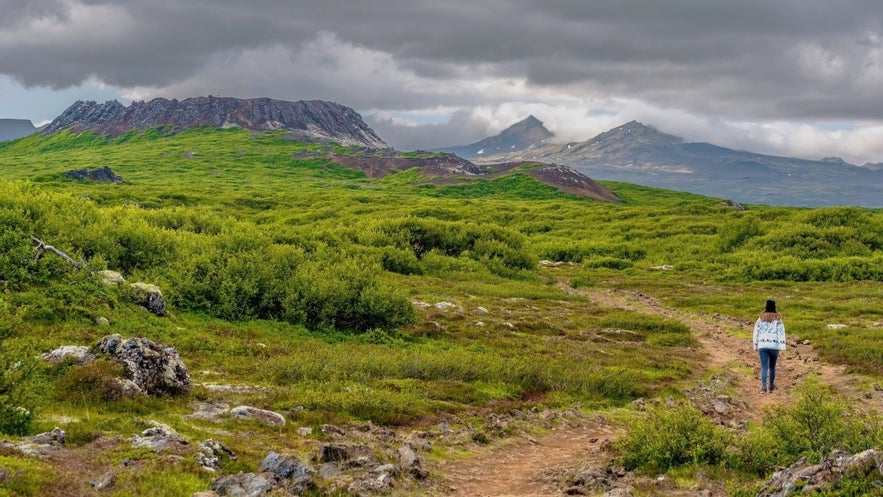 At the base of the Snaefellsnes Peninsula, you'll find the Eldborg Crater. This rounded formation stands 196 feet tall (60 meters) and stretches about 656 feet across (200 meters). Created by an eruption 5,000 to 8,000 years ago, it now offers a scenic and rewarding hike.
At the base of the Snaefellsnes Peninsula, you'll find the Eldborg Crater. This rounded formation stands 196 feet tall (60 meters) and stretches about 656 feet across (200 meters). Created by an eruption 5,000 to 8,000 years ago, it now offers a scenic and rewarding hike.
Hiking to the Eldborg Crater can take up to two hours, depending on how fast you walk and how much you explore. The path is pretty easy, though it's rather rocky, so it's best to bring good shoes. The crater itself features some beautiful lava formations in different colors, so it's well worth taking the time to visit.
10. Svodufoss Waterfall
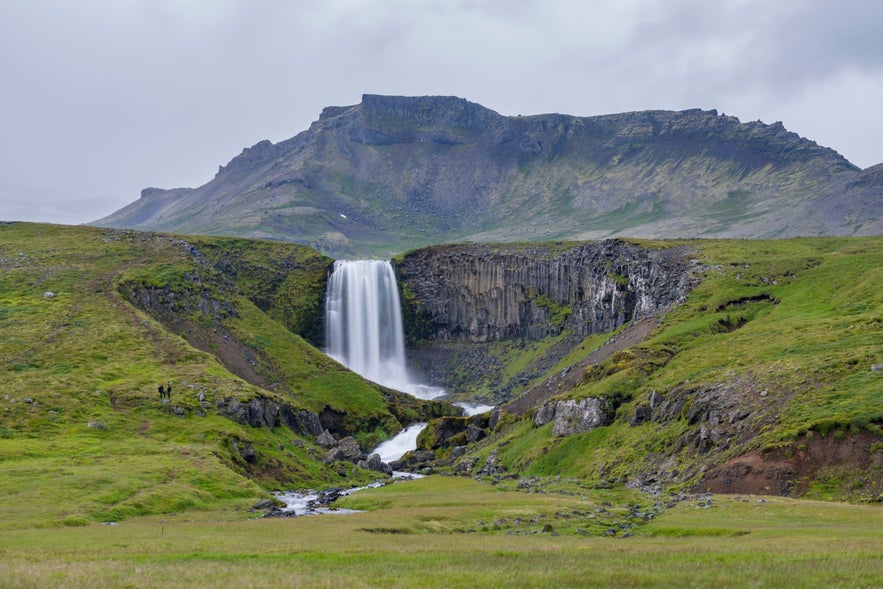 Not far inland from the northern coastline of the Snaefellsnes Peninsula lies the charming Svodufoss Waterfall, nestled against the backdrop of the snow-capped Snaefellsjokull Glacier. Known in Icelandic as "Svöðufoss," its scenic setting and gentle cascade over layered basalt cliffs make it a quiet highlight of the area.
Not far inland from the northern coastline of the Snaefellsnes Peninsula lies the charming Svodufoss Waterfall, nestled against the backdrop of the snow-capped Snaefellsjokull Glacier. Known in Icelandic as "Svöðufoss," its scenic setting and gentle cascade over layered basalt cliffs make it a quiet highlight of the area.
The waterfall is fed by a small river that flows from the highlands down toward the sea, dropping gracefully over ancient volcanic rock. On clear days, you’ll get a stunning view of Snaefellsjokull towering behind it, an ideal photo opportunity, especially in the golden light of early evening.
To reach Svodufoss, take a short detour off Route 574. The gravel road leading to the waterfall is generally manageable for small rental cars in summer, though you’ll want to take it slow. The path ends in a small parking area, from which it’s just a brief and easy walk to the viewpoint.
There’s no formal hiking trail, but the terrain is open and welcoming for a casual stroll. Because it's more hidden than some other attractions on the peninsula, Svodufoss offers a moment of quiet reflection in a landscape that feels truly Icelandic.
9. Djupalonssandur Black Beach
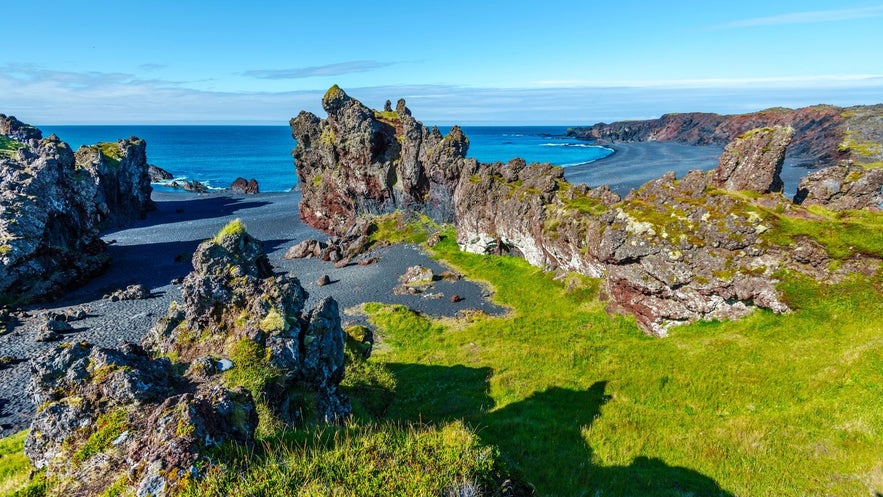 The Reynisfjara Black Sand Beach on Iceland's South Coast may be the most famous black beach in Iceland, but Djupalonssandur Beach rivals it in beauty and danger. This gorgeous beach contains black sand and perfectly round black pebbles shaped by the ocean waves, and it's surrounded by dramatic lava formations.
The Reynisfjara Black Sand Beach on Iceland's South Coast may be the most famous black beach in Iceland, but Djupalonssandur Beach rivals it in beauty and danger. This gorgeous beach contains black sand and perfectly round black pebbles shaped by the ocean waves, and it's surrounded by dramatic lava formations.
The name means "Deep Lagoon's Sand," as nearby you'll see the gorgeous Djupalon or "Deep Lagoon." Despite the name, the lagoon is merely 16 feet (5 meters) deep.
The beach is also known for its historic lifting stones, which fishermen of the past used to measure their strength. Their weight ranges from 55 to 340 pounds (25 to 154 kg), and you can try your hand at lifting them!
During your visit, you will also come across the ruins of a British trawler, the Epine GY7, which wrecked east of Dritvik Cove on March 13th, 1948. Fourteen men died, and the Icelandic search and rescue teams from neighboring towns saved five. The iron ruins are a memorial to the lives lost here.
Like at Reynisfjara, the surf is life-threateningly dangerous for visitors, with sneaker waves appearing out of nowhere and grabbing anyone who doesn't stay a safe distance away.
8. Ytri Tunga Beach
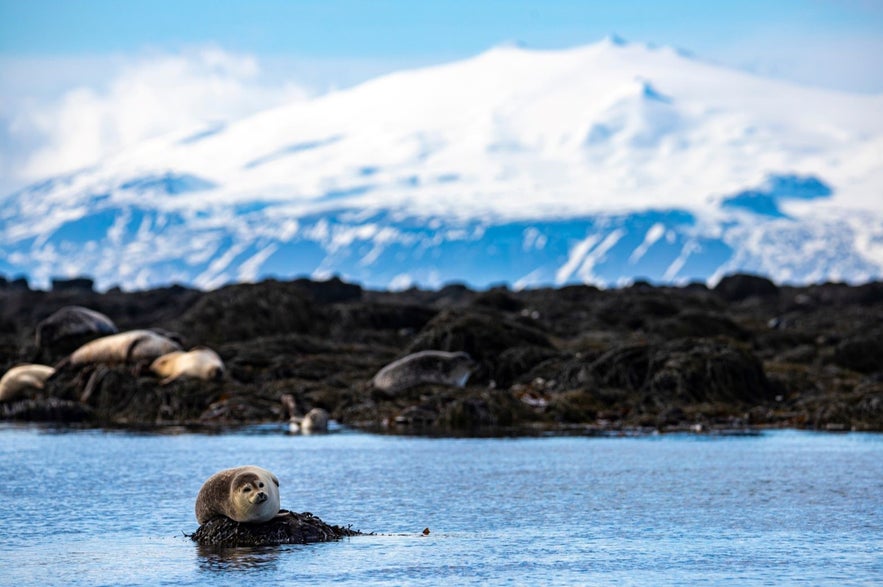 A special stop to include in your Snaefellsnes Peninsula itinerary is Ytri Tunga Beach. It's one of the few white-sand beaches in Iceland and a favored spot for those hoping to observe seals in their natural habitat.
A special stop to include in your Snaefellsnes Peninsula itinerary is Ytri Tunga Beach. It's one of the few white-sand beaches in Iceland and a favored spot for those hoping to observe seals in their natural habitat.
This sandy and rocky shore is home to a seal colony, where the animals can often be seen lounging or frolicking, particularly during the summer months.
Visitors are advised to maintain a respectful distance and to keep as quiet as possible, ensuring that the seals are not disturbed. The best time for seal watching in Iceland is in June and July.
7. Budir Black Church
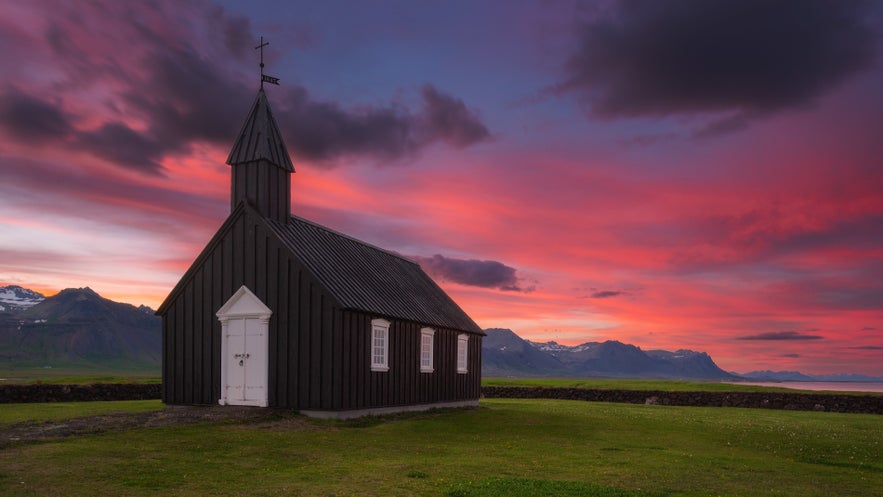
Budir is a small hamlet consisting of the iconic Budakirkja Black Church and the beautiful Hotel Budir. The iconic black church and its surroundings make for gorgeous photographs and draw in travelers. It's worth having a stroll in the area, and you can also enjoy a lovely lunch or dinner at the hotel restaurant.
The Budir Church’s construction dates back to 1703, but it rotted down over time. In 1848, by Steinunn Sveinsdóttir, a widow who lived in Budir, rebuilt the church in a different location. In 1984, it was moved in one piece from its former location by the old graveyard to its current location, where the local parish currently manages it. It's a very popular location to get married in Iceland.
If you're staying for more than a day in the region, then consider booking a night at Hotel Budir. It's one of the best hotels on the Snaefellsnes Peninsula, with an average rating of 4.6 out of 5 stars, and can make for a lovely romantic getaway or a comfortable base for your Snaefellsnes self-drive tour.
6. Londrangar Cliffs
The two Londrangar Cliffs sit along the seashore of Snaefellsjokull National Park, and you can see them from the main road. The cliffs are actually volcanic plugs formed thousands of years ago and were once part of a large crater.
The taller rock is 246 feet tall (75 meters), and the smaller one is 200 feet tall (61 meters), towering over a surrounding lava field. They're impressive from a distance, but you can also walk up to these towering rocks to truly appreciate their height. The hike is just over half a mile (1 kilometer) and takes around an hour.
Birdlife is rich in the area, and the view towards the Snaefellsjokull Glacier is stunning. The cliffs are also surrounded by folklore, as it's said that the smaller one is a troll man. His troll wife is found slightly further along the coastline. Some also believe that the larger cliff is an elf church and the smaller one an elf library.
People have successfully climbed both of the pinnacles; the first times were 1735 for the taller one and 1938 for the smaller one. However, we wouldn't recommend trying this if you aren’t a very experienced climber with proper gear, as they are very dangerous.
- See also: Londrangar and the Elves and much more
5. Vatnshellir Cave
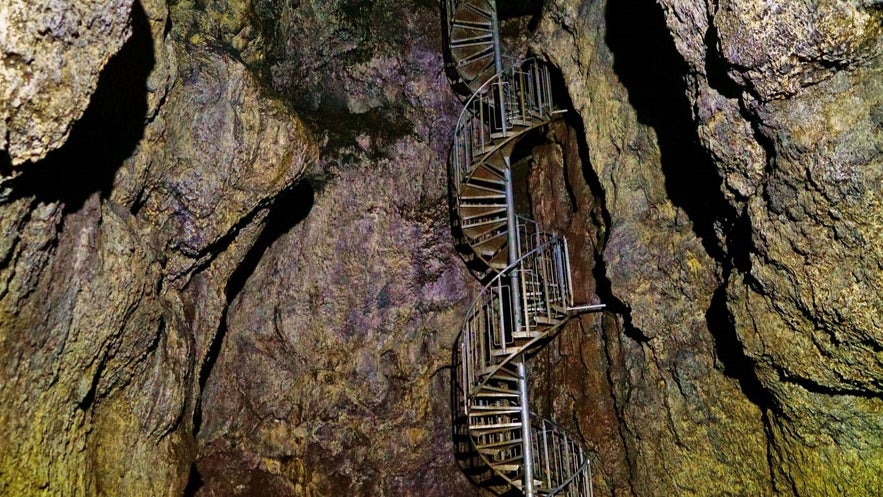 Vatnshellir Cave is an 8000-year-old lava cave on the Snaefellsnes Peninsula. It has only been open to the public since the summer of 2011, and it's only accessible with a guide like on this Vatnshellir Cave tour.
Vatnshellir Cave is an 8000-year-old lava cave on the Snaefellsnes Peninsula. It has only been open to the public since the summer of 2011, and it's only accessible with a guide like on this Vatnshellir Cave tour.
To enter the Vatnshellir cave, you descend down a spiral staircase 115 feet (35 meters) into the ground. You will then follow the flow of the ancient lava for about 656 feet (200 meters) and admire the colorful cave walls.
This is not a demanding walk, but you'll need a reasonable fitness level. The surface is a little uneven and sometimes sharp, so wear good hiking shoes and warm clothing, including gloves. You’ll receive a helmet and a torch during the tour.
4. Arnarstapi and Gatklettur Rock
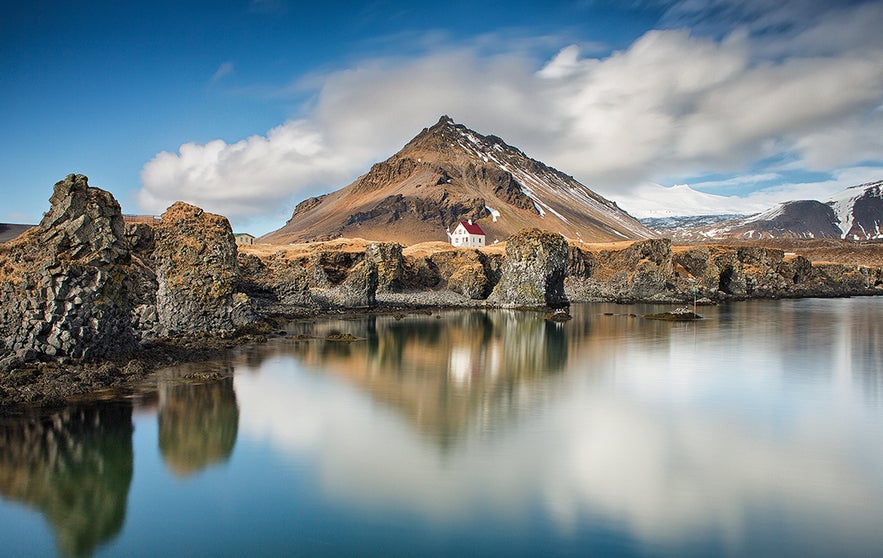
Arnarstapi is a tiny settlement next to the pyramid-shaped mountain Stapafell. It used to be an important trading post with a much larger population. Now it only has very few houses, an information center, and a small pier for small boats, as well as a sculpture of the mythical half-man, half-troll Bárður Snæfellsás by artist Ragnar Kjartansson.
There are also accommodation options in Arnarstapi, which can be convenient if you want to spread your Snaefellsnes Peninsula exploration over two or more days.
Arnarstapi Hotel is one of the nicest places to stay, offering the perfect base for discovering the area’s natural wonders. The hotel is ideally located near key attractions and is home to the Snjófell Restaurant, making it an excellent choice for visitors who want to immerse themselves in the beauty of the region.
Arnarstapi sits on a large lava field that has beautiful seaside views and some interesting rocks along the coastline. A colony of Arctic terns resides in the small hamlet, and a walk along the seashore is recommended to enjoy the lava formations and the rich birdlife.
The most famous rock formation in the area is Gatklettur, or "Hole Rock." The name is obvious, as there is a giant hole through the rock, which looks stunning in pictures with the waves crashing through it. It's even more breathtaking in person as you gaze out to sea whilst listening to the waves and the stillness surrounding you.
The seaside and the cliffs between the Arnarstapi settlement and the nearby Hellnar Hamlet became a Natural Reserve in 1979 and are now a part of Snaefellsjokull National Park. The walk from Arnarstapi to Hellnar is approximately 30 minutes one way and comes highly recommended.
3. Ondverdanes and Svortuloft Cliffs
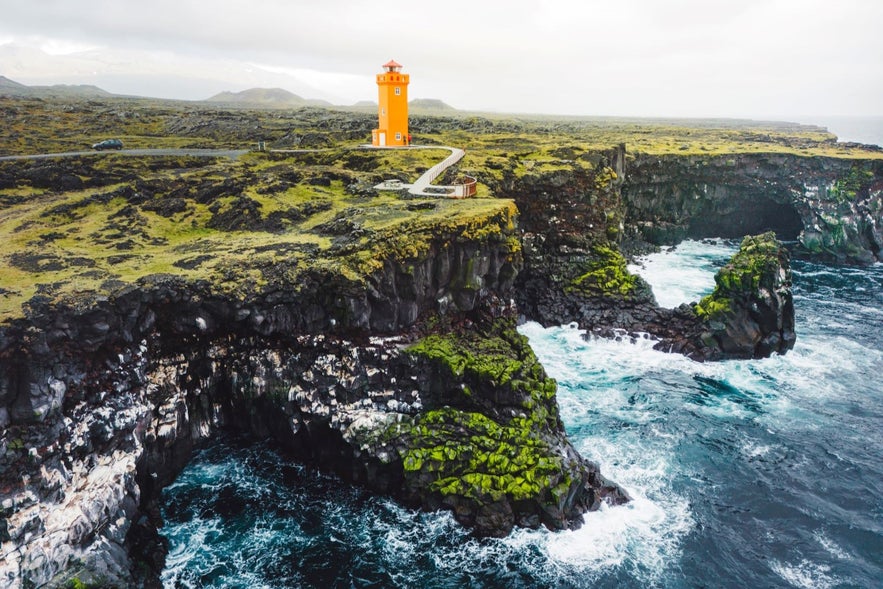
The westernmost point of the Snaefellsnes Peninsula is called the Ondverdarnes Cape, and it's where you'll find the dramatic Svortuloft Cliffs or "Black Ceilings." They also have the names Nesbjarg (Peninsula Cliff) and Saxholsbjarg (Knife Hill Cliff), depending on whether you're approaching them from the sea or land.
The cliffs were formed when hot lava erupted from the Snaefellsjokull Volcano out to sea, and then the forceful waves of the Atlantic Ocean broke off the outer rocks, leaving the vertical cliffs behind. The area is absolutely stunning, especially as it all contrasts with the orange Skalasnagaviti Lighthouse that sits on top of the cliffs.
You'll have to drive for 15-20 minutes along a gravel road to reach this area. For safety, we recommend doing this when there's no strong wind and in summer when the weather is milder.
You can easily access it with a small rental car, but drive slowly and carefully, as the road can be a bit rough. Along the way, you can stop in Skardsvik, a lovely white sand beach surrounded by lava rocks.
It's also the location of a 10th-century Viking burial mound that was excavated in 1962. You'll find interesting information signs with details about the archeological find, and it's worth a short stop along your way.
You can also take a detour to the tiny orange Ondverdanes lighthouse, which is full of history. It used to be a fishing station, and some archeological remains are still visible along the coast.
2. Snaefellsjokull National Park
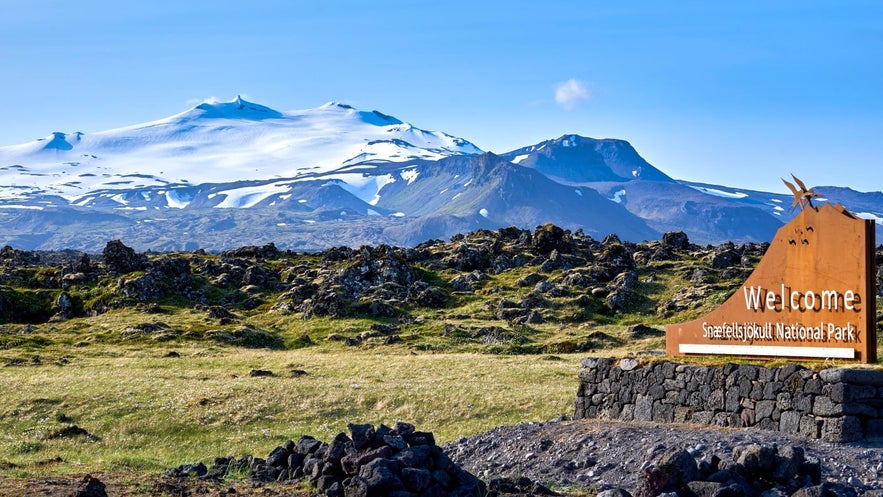 Iceland has three national parks, one of which surrounds the Snaefellsjokull Glacier and reaches the seashore of the Snaefellsnes Peninsula. The Snaefellsjokull National Park was established in 2001 and covers 66 square miles (170 square kilometers). Within it are numerous beautiful attractions, including rock formations, lava fields, and volcanic craters.
Iceland has three national parks, one of which surrounds the Snaefellsjokull Glacier and reaches the seashore of the Snaefellsnes Peninsula. The Snaefellsjokull National Park was established in 2001 and covers 66 square miles (170 square kilometers). Within it are numerous beautiful attractions, including rock formations, lava fields, and volcanic craters.
If you don't have time to explore all of the Snaefellsnes Peninsula, you can focus on those within the Snaefellsjokull National Park — we featured many on this list! Also, explore the many hiking trails, check out bird colonies along the coastal areas, and enjoy the peacefulness and stark beauty of the Icelandic wilderness.
The main highlight of the park is the Snaefellsjokull Glacier. It famously featured as the entrance to the Earth's core in Jules Verne’s sci-fi classic "Journey to the Center of the Earth." It was also the setting for another novel, Kristnihald undir Jökli, or "Under the Glacier" by Icelandic Nobel Prize winner Halldór Laxness.
The Snaefellsjokull Glacier is 4,744 feet tall (1,446 meters) and is situated on top of a 700,000-year-old stratovolcano. Currently, the glacier covers around 10 km2, half the size it was around the year 1900.
We recommend taking the time to visit Malarrif, the main visitor center for the park, which has an interesting exhibition about the surrounding nature and history of the park. It will make your visit to the region more insightful and enjoyable!
- See also: National Parks in Iceland
- See also: Icelandic Literature for Beginners
1. Kirkjufell Mountain
One of Iceland’s most iconic attractions is Kirkjufell Mountain, along the Snaefellsnes Peninsula coastline. It featured in the popular series Game of Thrones as "Arrowhead Mountain," but it had been a popular location among photographers and nature enthusiasts long before that.
The mountain is only 1,519 feet (463 meters) and has a triangular shape from one particular angle. However, it has a wider trapezoid shape if you see it from the nearby Grundarfjordur Town.
You may get some amazing views of the mountain on still days with the calm sea reflecting it. This picture is especially beautiful when the mountain is snow-crusted in winter or when the sunset reflects off the water.
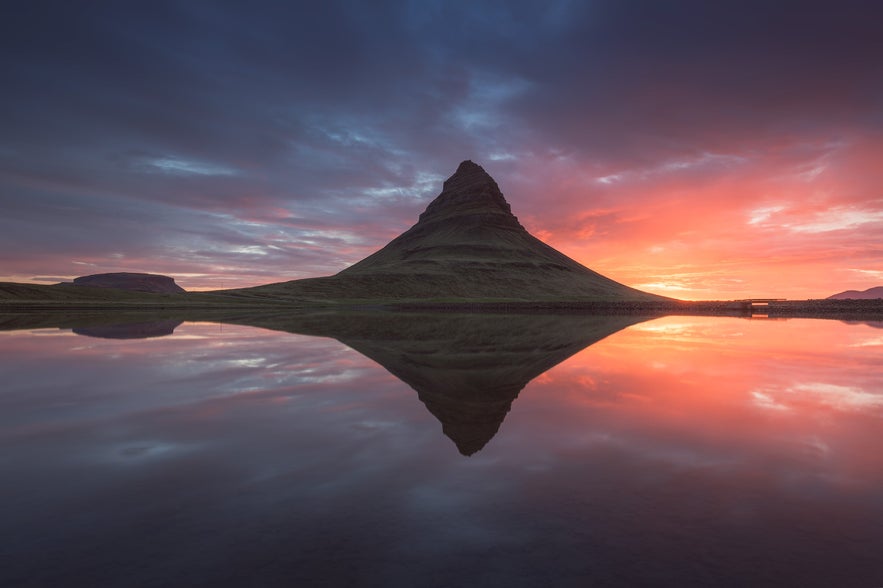 The most popular spot to photograph it from is by the side of the road, where it has its iconic triangular shape and where a small waterfall named Kirkjufellsfoss trickles down the opposite hillside. This waterfall is the perfect foreground, with Kirkjufell Mountain casually filling the backdrop.
The most popular spot to photograph it from is by the side of the road, where it has its iconic triangular shape and where a small waterfall named Kirkjufellsfoss trickles down the opposite hillside. This waterfall is the perfect foreground, with Kirkjufell Mountain casually filling the backdrop.
Like all other locations on the Snaefellsnes Peninsula, this location is popular all year round. Travelers enjoy the gorgeous landscape when it's covered in snow with dancing auroras overhead, as well as when it's fully green and bathing in light from the midnight sun.
- See also: Movie Locations in Iceland
- For more: Weather in Iceland & Best Time to Visit
Top 5 Activities to Do on the Snaefellsnes Peninsula
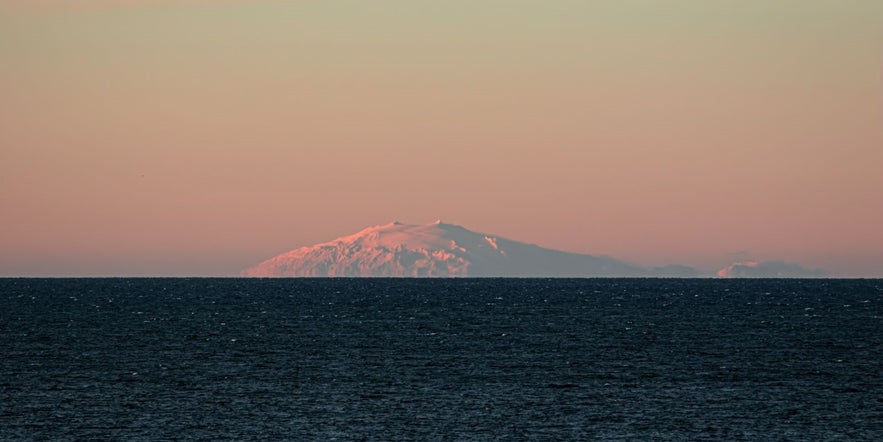 Adding fun activities and experiences to your travel itinerary between visits to iconic locations is a great way to maximize your experience. Here are some of the best things to do on the Snaefellsnes peninsula.
Adding fun activities and experiences to your travel itinerary between visits to iconic locations is a great way to maximize your experience. Here are some of the best things to do on the Snaefellsnes peninsula.
5. Explore Flatey Island
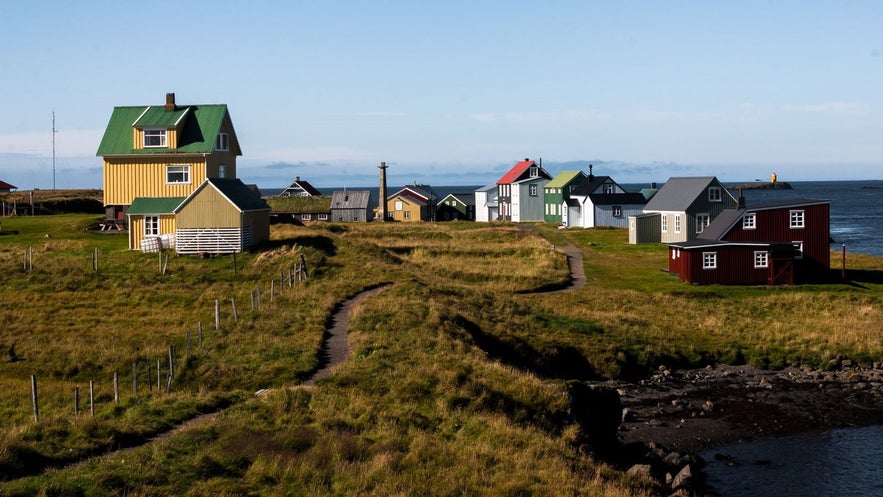 If you're staying multiple days on the Snaefellsnes Peninsula in summer, consider visiting Flatey Island. It's an isolated island in the Breidafjordur Bay with a tiny village, which people mostly inhabit during the summer months.
If you're staying multiple days on the Snaefellsnes Peninsula in summer, consider visiting Flatey Island. It's an isolated island in the Breidafjordur Bay with a tiny village, which people mostly inhabit during the summer months.
To access Flatey Island, you have to take the Baldur Ferry to the Westfjords, which departs from the charming town of Stykkisholmur. It's worth spending the afternoon walking around the island, seeing the colorful traditional houses, observing the birdlife, and enjoying the tranquility.
The Flateyjarkirkja Church is very beautiful, as the painter Baltasar Samper filled the ceiling with unique scenes from daily life on the island. The altar also depicts a lovely religious scene where Jesus wears an Icelandic Lopapeysa sweater.
You can enjoy a meal at the Hotel Flatey or bring food with you to eat in nature. Then, you can take the ferry back to Stykkisholmur or continue your journey to the Westfjords.
- For more: A Local's Guide to the Secluded Flatey Island
- See also: 25 Hidden Gems in Iceland
4. Relax in the Lysulaugar Mineral Algae Baths
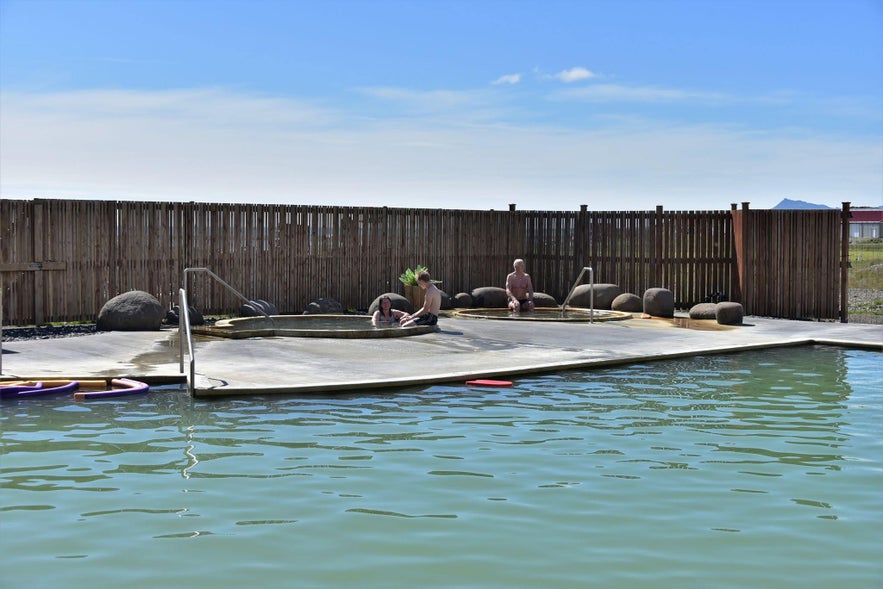
Iceland is known for its abundance of hot springs and geothermal pools, which you can find all over the country. On the Snaefellsnes Peninsula, however, you can visit the unique Lysulaugar Algae Baths.
This thermal pool is known for its green water, which is rich with chlorella algae and various minerals. Much like the blue waters of the famous Blue Lagoon on the Reykjanes Peninsula, many believe the algae water at Lysulaugar is great for the skin.
The entry is also very affordable, and you'll be able to unwind in the warm water with great views of the surrounding mountains. The Lysulaugar Thermal Pool is mostly open from June to mid-August. Lysulaugar’s Facebook page also advertises special openings throughout the year.
- See also: Best Swimming Pools in Iceland
3. Visit the Bjarnarhofn Shark Museum
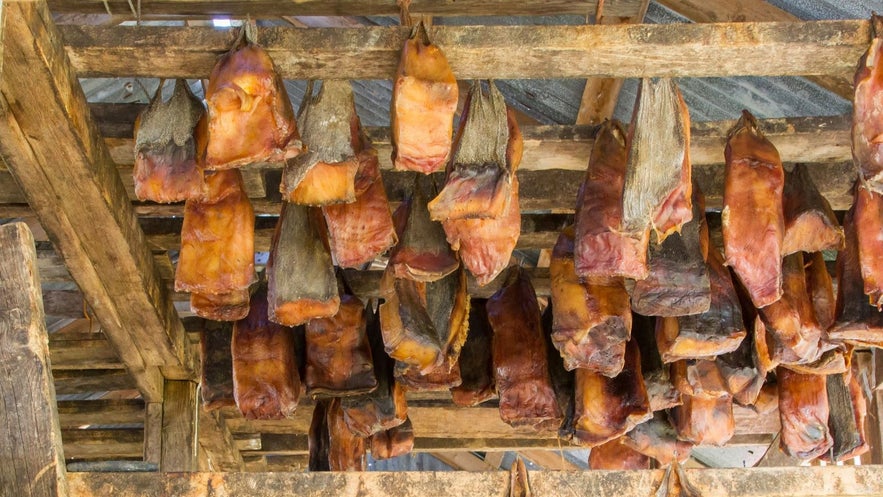 One of the best things to do when visiting a new country is to try the local food. When it comes to historic Icelandic food, however, not all dishes are equally enticing. The most infamous Icelandic dish is probably the Hakarl, or fermented shark, which is somewhat of a test of bravery for visitors.
One of the best things to do when visiting a new country is to try the local food. When it comes to historic Icelandic food, however, not all dishes are equally enticing. The most infamous Icelandic dish is probably the Hakarl, or fermented shark, which is somewhat of a test of bravery for visitors.
This is why you shouldn't miss out on a visit to the Bjarnarhofn Shark Museum. It's a must-stop on the Snaefellsnes Peninsula for anyone interested in Icelandic culture. You'll learn about shark fishing in Iceland through the centuries and its cultural significance. You'll see how locals prepare the dish, and you'll get to try it out for yourself!
Afterward, you can enjoy a delicious meal at their on-site cafe, making it a great addition to your travel itinerary.
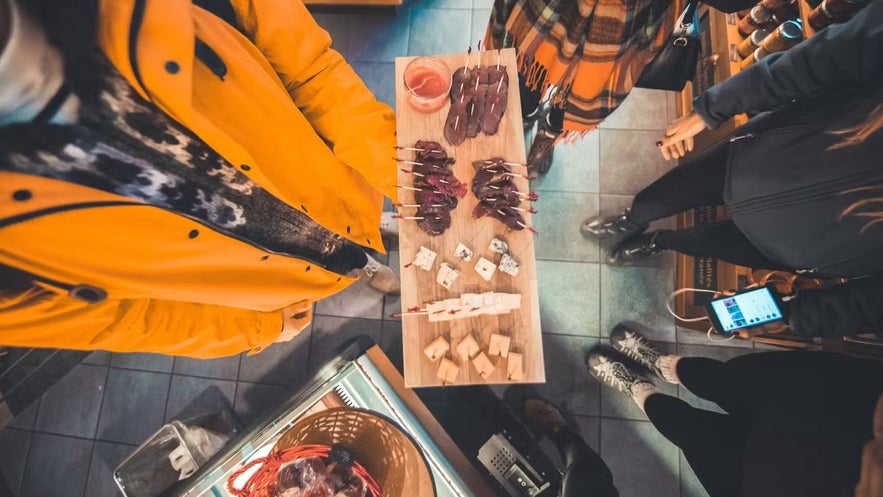
If you don't want to try fermented shark, you can still enjoy a fantastic food experience on the Snaefellsnes Peninsula. You can go on this seafood boat cruise from Stykkisholmur, where you'll get to explore the beautiful Breidafjordur Bay while enjoying the freshest possible seafood in Iceland!
But if your time is limited, we recommend trying fermented shark and other dishes as part of a food walking tour in Iceland. You'll get to know more about modern and traditional Icelandic food with the help of an informative guide.
A great option for this experience is this highly-rated Reykjavik food walk tour, where you'll get to try a variety of traditional food along with delicious modern dishes in some of Reykjavik's best restaurants!
2. Explore the Snaefellsjokull Glacier
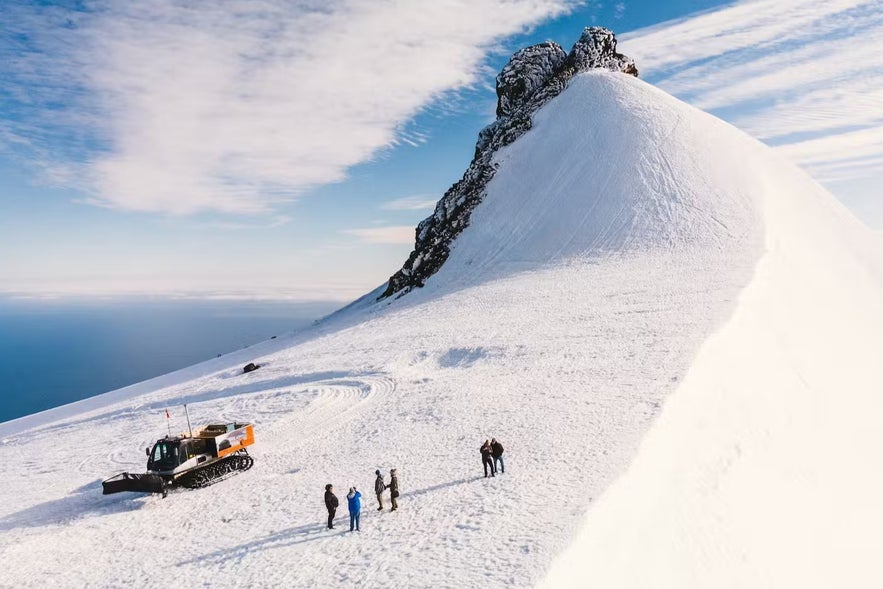
The crowning jewel of the Snaefellsnes Peninsula is the dramatic Snaefellsjokull Glacier, which towers over the surrounding landscape. Many hiking trails in the area will lead you to the glacier’s roots, but you should never try to go on the ice without a qualified guide!
This makes a Snaefellsjokull tour one of the best things to do in the region. During summer, you can go on this glacier hiking tour on Snaefellsjokull Glacier, where you'll receive glacier hiking equipment and expert guidance. You'll see beautiful views of the surrounding nature as you ascend to the top. In total, the experience takes around six to seven hours.
The hike is suitable for most as it isn't very challenging, but you can add to the thrill with this Snaefellsjokull Glacier snowcat tour! The snowcat vehicle will easily bring you to the top, where you can admire the setting of Jules Verne's book "Journey to the Center of the Earth."
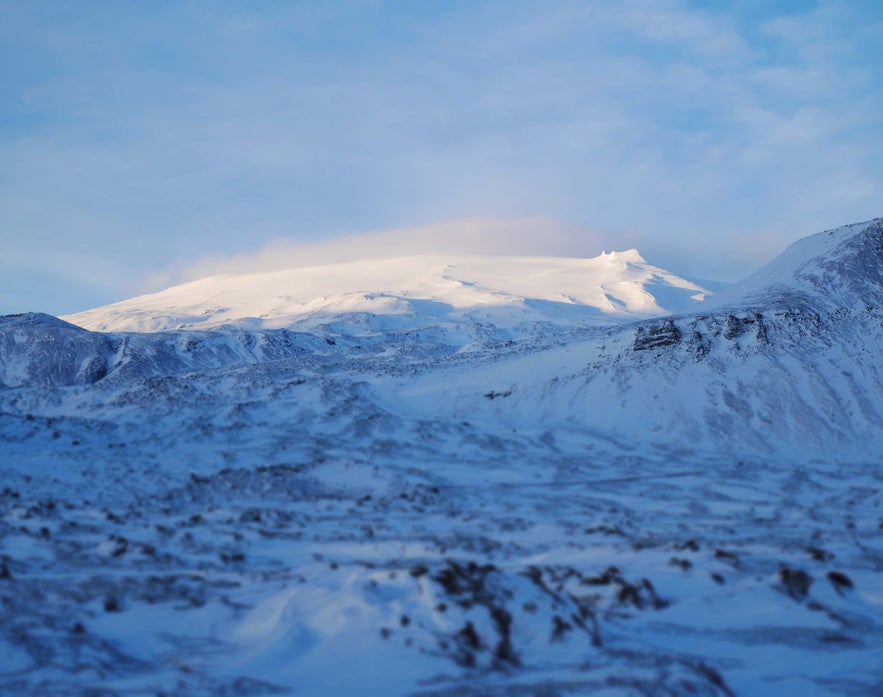
While on the top, you may even have a unique experience. Some talk about feeling a very strong energy surrounding the Snaefellsjokull Glacier Volcano. Those in tune with such things consider it one of the world’s biggest and strongest energy fields.
Aliens were even predicted to land on top of the glacier on November 5th, 1993, at 9:03 PM. Hundreds of people gathered to welcome them, but the effort was unsurprisingly fruitless.
It is little wonder that they were attracted to the volcano's cone shape, which is visible all the way from Reykjavik on clear days — a distance of 75 miles (120 kilometers).
All of these factors have contributed to the Snaefellsjokull Glacier Volcano becoming one of the most famous, must-see attractions in Iceland.
1. Puffin Tours and Whale Watching on the Breidafjordur Bay
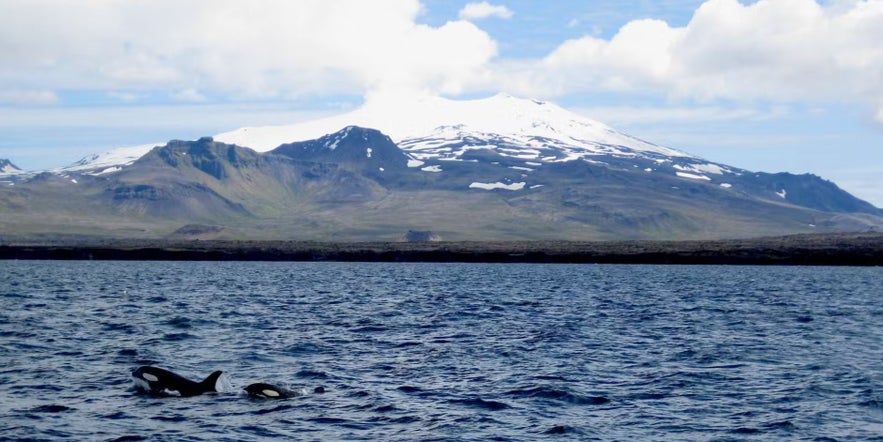
One of the best things to do in Iceland is to go on whale-watching and puffin tours, which you can do off the Snaefellsnes Peninsula coast! This whale-watching tour on the Breidafjordur Bay departs from the small town of Olafsvik and brings you closer to the gentle giants of the sea.
This region offers great chances for spotting orcas and sperm whales, but you may also see minke whales, harbor porpoises, white-beaked dolphins, or even humpback whales! With knowledgeable guides on board, you'll learn about the whales’ behaviors, conservation efforts, and the area’s rich biodiversity.
The Breidafjordur Bay area is brimming with birdlife, and you can sometimes find puffins nesting on the cliffsides during summer!
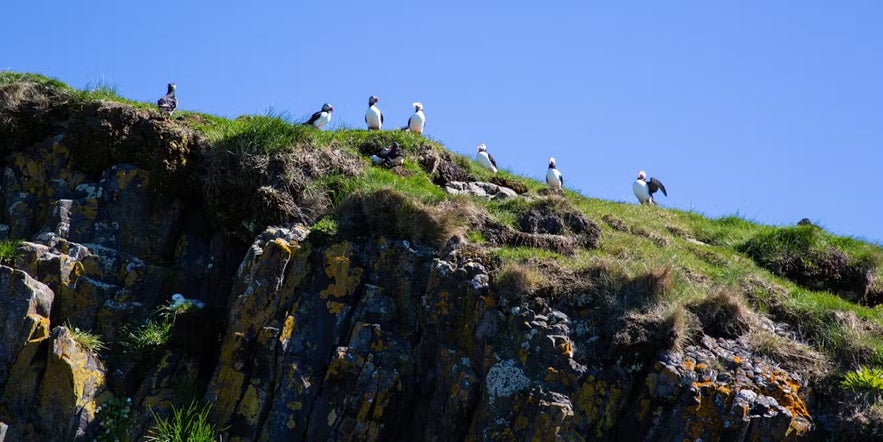
Sailing around Breidafjordur Bay will provide stunning views of the surrounding mountains, and you'll be able to see some of the bay's many islands. It's an easy addition to your Snaefellsnes Peninsula travel itinerary that's sure to be a memorable experience.
- Learn more with the Best Guide to Whale Watching in Iceland
- See also: Birds in Iceland
How to Get to the Snaefellsnes Peninsula
The Snaefellsnes Peninsula is easily accessible by car from Reykjavik, making it a popular destination for day trips or overnight stays. To drive there, take Route 1 (the Ring Road) north from Reykjavik, then connect to Route 54, which leads you onto the peninsula.
From there, Route 574 circles around the tip of the peninsula, and Route 56 connects you back to Route 54 to complete the loop. Driving the full circle takes just over two hours, but plan for at least eight hours if you want to explore the region’s major sights.
If you only have one day, booking a tour can be a stress-free and efficient way to experience the area. A great option is this small group tour of the Snaefellsnes Peninsula from Reykjavik, which covers key highlights and operates year-round.
- For more: Driving in Iceland: The Ultimate Guide to Road Trips
- See also: How to Drive Safely in Iceland
Visiting the Snaefellsnes Peninsula in Summer
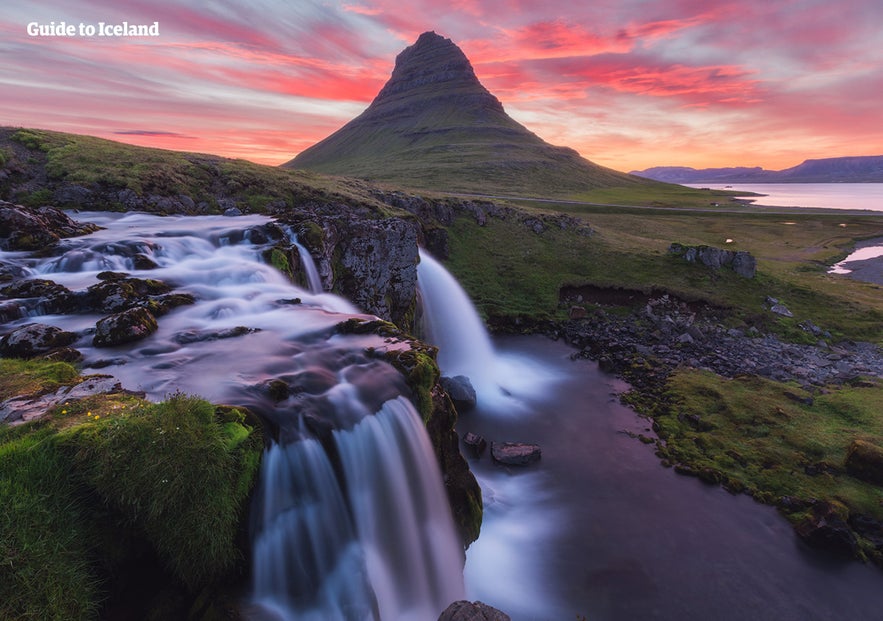
Summer in Iceland is the best time to visit the Snaefellsnes Peninsula as the weather is warmer and the days are much longer because of the midnight sun. This means that you can make the most of your time and include more activities in your travel itinerary. You can also reach most attractions with a small rental car!
The only downside to visiting in summer is that major attractions will be more crowded as it's the high travel season in Iceland. With determination, however, you can still have a peaceful experience. For more privacy at major attractions, go in the late evening! You'll likely have the place to yourself and still be able to enjoy the benefits of daylight.
This is best if you're staying in accommodation in the Snaefellsnes Peninsula, so you can easily return to your room for rest instead of driving through the night back to Reykjavik.
Visiting the Snaefellsnes Peninsula in Winter
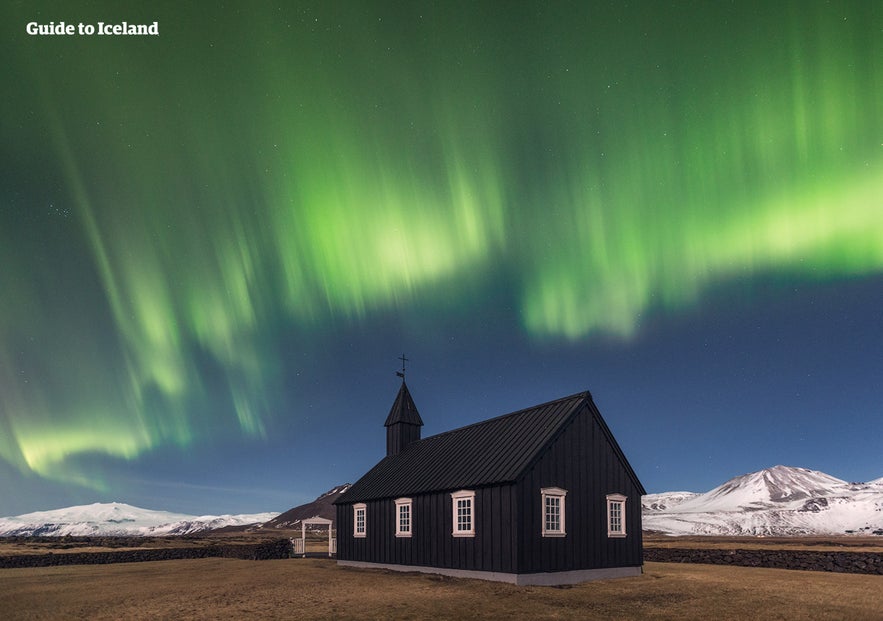
The Snaefellsnes Peninsula is generally accessible in winter, though you will need to keep your plans flexible as the Icelandic weather can be unpredictable. The roads may have ice and snow, and some mountain roads may close temporarily because of poor conditions.
Because of this, we recommend that you rent a 4x4 vehicle if you plan to drive yourself or simply choose a guided tour for your Snaefellsnes exploration.
Even though driving in the Icelandic winter can be a challenge, there are many worthwhile things to see during the darker months. The mountains will be covered in snow, waterfalls turn into frozen columns, and you may see the northern lights dancing in the sky above the white landscapes!
The Saefellsnes Peninsula is a great location for spotting the northern lights in Iceland, as you'll easily find spots secluded from light pollution. You just have to check the aurora forecast and hope for a cloudless sky.
Bonus: Top 5 Towns to Visit
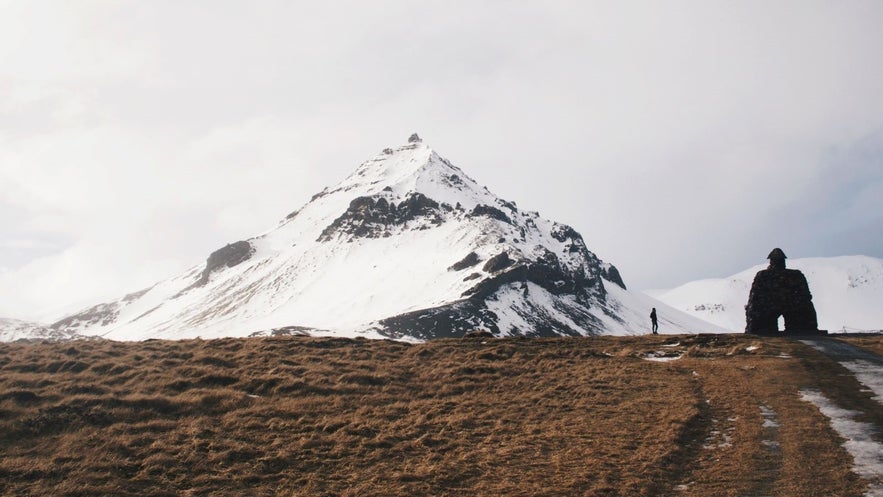 As you travel through the region, you'll pass through some lovely towns and villages that are worth a stop. This is also where you'll find the best Snaefellsnes Peninsula accommodations if you're planning to spend more than a day in the area.
As you travel through the region, you'll pass through some lovely towns and villages that are worth a stop. This is also where you'll find the best Snaefellsnes Peninsula accommodations if you're planning to spend more than a day in the area.
Since the village of Arnarstapi already has a special mention on this list, here are more towns to visit on the peninsula.
5. Hellnar
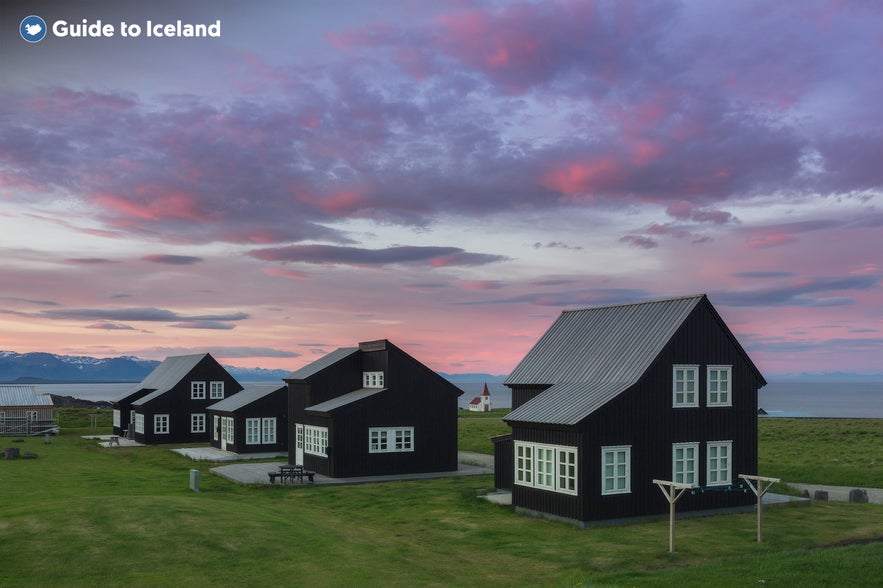 Hellnar is a small hamlet on the southern coast of the Snaefellsnes Peninsula that's just a 10-minute drive away from the Malarrif Visitor Center. It's known for its seaside cliffs and the Badstofa cave, which has unique lighting. It's a great place for beautiful photographs.
Hellnar is a small hamlet on the southern coast of the Snaefellsnes Peninsula that's just a 10-minute drive away from the Malarrif Visitor Center. It's known for its seaside cliffs and the Badstofa cave, which has unique lighting. It's a great place for beautiful photographs.
There are multiple hiking paths in the vicinity, and we recommend walking along the coast to the village of Arnarstapi. It will take around an hour one way, and you'll have beautiful views of lush lava fields, the rugged coast, and the Snaefellsjokull Glacier.
Once you return, you can enjoy a cup of coffee or a meal at the Fjoruhusid Cafe. It's only open in summer, but it has amazing views over the ocean.
Where to Stay in Hellnar
If you're spending multiple days in the region, you can spend a night in Hellnar. It's conveniently located along the edge of the Snaefellsnes Peninsula, close to the Snaefellsjokull National Park.
A good option for your stay in the town is the Fosshotel Hellnar, which has an average rating of 8.8 out of 10 stars from over 350 guests. You can choose from varied room types to suit different needs and budgets. This is a popular location, especially in summer, so make sure to book your stay in advance.
4. Hellissandur
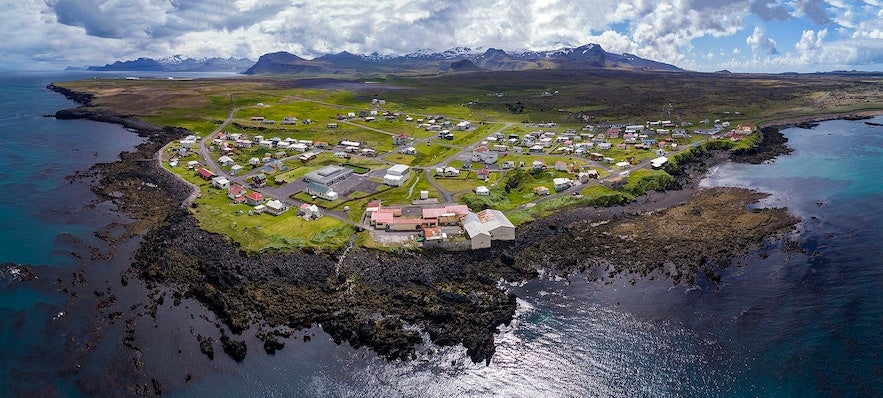
Photo above from Wikimedia, Creative Commons, by Chensiyuan. No edits made.
The small village of Hellissandur sits near the tip of the Snaefellsnes Peninsula and is just next to the Snaefellsjokull National Park. It's conveniently located near some of the region's top attractions, including Kirkjufell Mountain, which is just a 30-minute drive away — about 21 miles (33 kilometers).
You can enjoy a charming art walk around the village, as you'll find many colorful and interesting murals featured on the walls of different buildings in the "Street Art Capital of Iceland." If you're visiting in summer, you can treat yourself to a delicious meal at the local restaurants.
If you're planning a thorough exploration of the Snaefellsjokull National Park, Hellissandur is the place to stay. It's also where you'll find one of the two service centers for the park.
Where to Stay in Hellissandur
You can stay in Hellissandur accommodations if you want to experience all that this town has to offer and its beautiful surroundings. For a comfortable stay, you can book a night at the Freezer Apartments. You'll enjoy complete privacy in a studio apartment with views over the ocean. It's a great retreat into nature and a convenient location.
3. Grundarfjordur
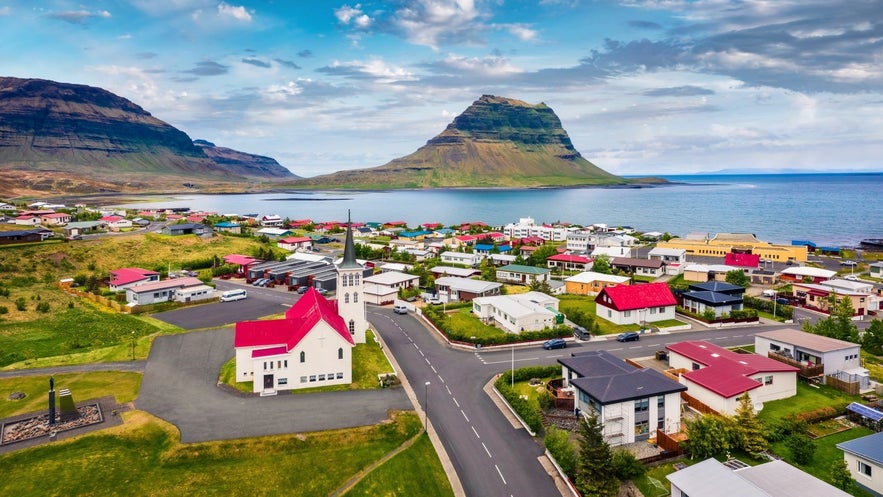 Grundarfjordur is one of the larger towns on the Snaefellsnes Peninsula. You'll find restaurants, a lovely church, an interesting historical center, and a peaceful swimming pool. The town also has a 9-hole golf course, and you can even try your hand at frisbee golf!
Grundarfjordur is one of the larger towns on the Snaefellsnes Peninsula. You'll find restaurants, a lovely church, an interesting historical center, and a peaceful swimming pool. The town also has a 9-hole golf course, and you can even try your hand at frisbee golf!
It's also the location of the famous Kirkjufell Mountain, which sits on the edge of the Grundarfjordur Fjord. You'll have great views of the mountain from most places in the town.
Where to stay in Grundafjordur
If you want to stay close to Kirkjufell Mountain, then it's best to find accommodation in Grundarfjordur. You can book a night at the Old Post Office Guesthouse, which has lovely views of the surrounding mountains.
You'll enjoy comfortable rooms with a private bathroom and access to a shared kitchen. The hotel’s convenient location makes it a good base for exploring the surrounding attractions.
2. Olafsvik
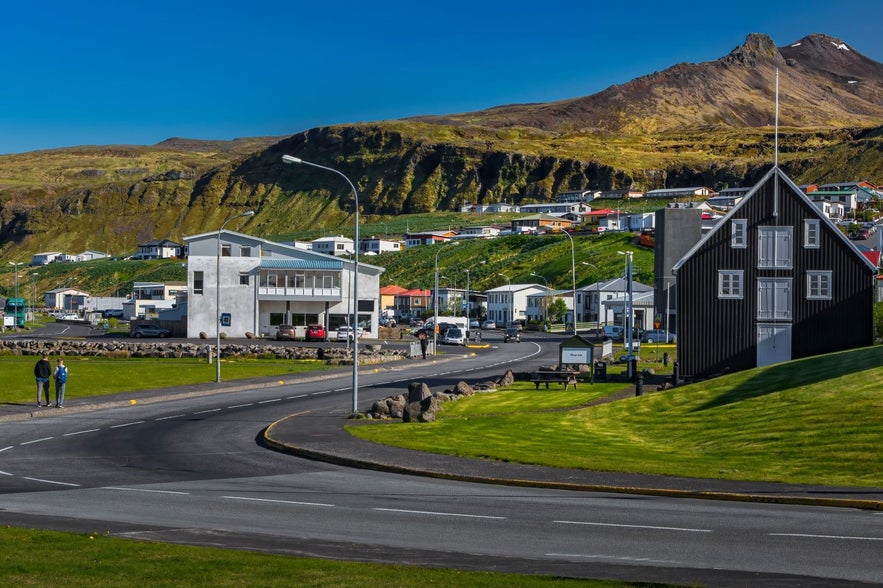 The charming town of Olafsvik is a good base for exploring the Snaefellsnes Peninsula. It has a lively harbor where you can go whale watching. There's also a very charming museum in the town center known as Pakkhusid. In the vicinity, you'll also find cozy restaurants, a nice swimming pool, and a grocery store.
The charming town of Olafsvik is a good base for exploring the Snaefellsnes Peninsula. It has a lively harbor where you can go whale watching. There's also a very charming museum in the town center known as Pakkhusid. In the vicinity, you'll also find cozy restaurants, a nice swimming pool, and a grocery store.
Olafsvik has a modern church that sits above a painted rainbow street framed by a picturesque mountainside. If you're looking for a cute photo opportunity, you'll also find a sign by the church that instructs visitors to share a kiss!
Close by, you can enjoy a walk to a beautiful waterfall, which also offers great views of the surrounding area. There's also a lovely memorial garden dedicated to sailors who have lost their lives at sea.
Where to Stay in Olafsvik
This peaceful town makes for a good base when spending multiple days on the Snaefellsnes Peninsula. Choose from different accommodation options in Olafsvik and enjoy a comfortable stay. The most unique place to stay is the Freezer Hostel, just a 7-minute drive outside Olafsvik.
This hostel doubles as a theater and a music venue, focusing on bringing live arts to the surrounding community. Local and international bands and solo artists have also performed here, so there's always something interesting going on. It’s well worth a visit, even if you decide to stay elsewhere!
If you prefer to stay in the center of Olafsvik, you can stay at the North Star Hotel Snaefellsnes. Alternatively, you can rent one of the Welcome Apartments Olafsvik for a home-away-from-home. Also, check out the Sker Restaurant for a delicious bite to eat with a cozy atmosphere while staying in the area!
1. Stykkisholmur
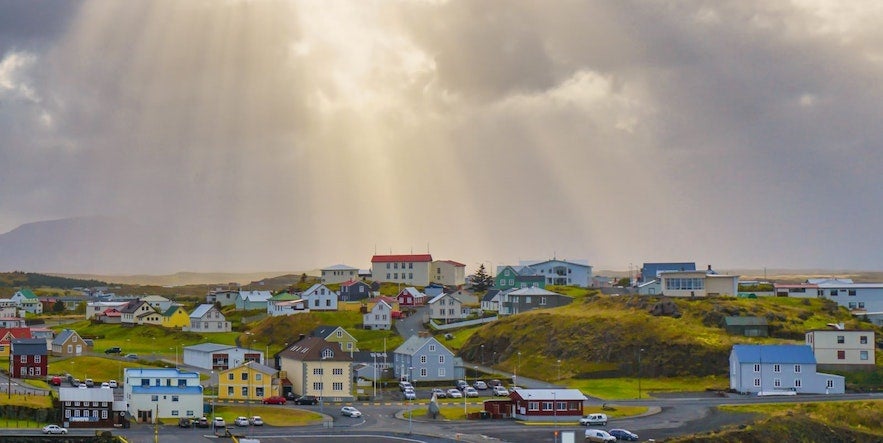
Stykkisholmur is the largest town on the Snaefellsnes Peninsula, known for its colorful traditional houses and beautiful harbor. You may also have seen Stykkisholmur in the film “The Secret Life of Walter Mitty,” where it was used as the setting for Nuuk in Greenland.
You can find multiple grocery stores, local shops, restaurants, cafes, bakeries, and other services around town. There are also cultural attractions like the historic Norwegian House and the Library of Water exhibition. The local swimming pool also has a fun waterslide!
You'll find a number of boat trips operating from Stykkisholmur to the wide Breidafjordur Fjord. These include different tours and the ferry Baldur, which crosses to the Westfjords with a stop at the tranquil Flatey Island.
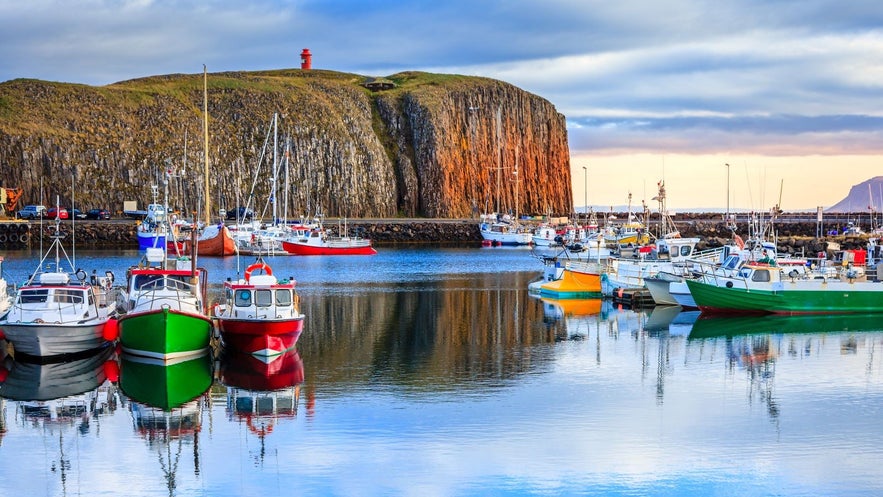 The harbor is framed by the beautiful Sugandisey Island, which you can easily access on foot. Take the time to walk around it and take in the great views of the surrounding bay. You can also visit a tiny lighthouse that sits at the very top of the island.
The harbor is framed by the beautiful Sugandisey Island, which you can easily access on foot. Take the time to walk around it and take in the great views of the surrounding bay. You can also visit a tiny lighthouse that sits at the very top of the island.
Stykkisholmur has a lot to offer and is worth spending a day exploring. It's also the best place to stay for multiple days on the Snaefellsnes Peninsula.
Where to Stay in Stykkisholmur
As the largest town on the Snaefellsnes Peninsula, you'll have varied options for accommodations in Stykkisholmur. There is a campsite in town, as well as a few hostels, homestays, rental apartments, and hotels.
One of the most charming places to stay in Stykkisholmur is the Hotel Egilsen. You'll be staying in a historic red building close to the harbor, with easy access to surrounding attractions.
Another option is the Fosshotel Stykkisholmur, which is probably the largest hotel in town. It offers comfortable and modern rooms.
- See more about Stykkisholmur and the Trip back to Reykjavik
FAQ About Things To Do on the Snaefellsnes Peninsula
Here are some of the most common questions about things to do in Snaefellsnes Peninsula.
What To Do in Snaefellsnes Peninsula?
Explore stunning landscapes, visit Saefellsjokull National Park, relax in the charming coastal towns, and see the black sand beaches.
How Long To Spend at Snaefellsnes Peninsula?
Plan for 1-2 days to fully experience the highlights and enjoy the unique sites without rushing.
How Long Does It Take To Drive Around Snaefellsnes Peninsula?
It takes about 4-6 hours to drive around the peninsula, but you’ll want more time to explore.
What Is the Best Time To Visit Snaefellsnes Peninsula?
The best time to visit is during summer (June to August) for mild weather and accessible roads, though winter offers fewer crowds and beautiful snow-covered landscapes.
Are There Hot Springs in Snaefellsnes Peninsula?
Yes, you can find a few natural hot springs, like the Landbrotalaug Hot Spring, perfect for a relaxing soak while enjoying the surrounding beauty.
Explore the Top Things to Do on the Snaefellsnes Peninsula
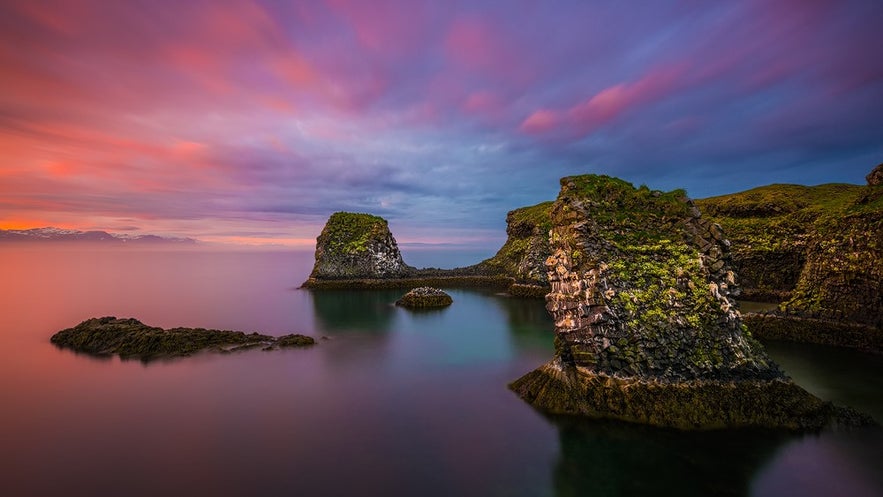 The Snaefellsnes Peninsula is one of Iceland’s most breathtaking and diverse regions. From the snowcapped Snaefellsjokull Glacier to dramatic coastlines, black sand beaches, lava fields, and charming fishing villages, it perfectly captures the essence of Iceland’s natural beauty.
The Snaefellsnes Peninsula is one of Iceland’s most breathtaking and diverse regions. From the snowcapped Snaefellsjokull Glacier to dramatic coastlines, black sand beaches, lava fields, and charming fishing villages, it perfectly captures the essence of Iceland’s natural beauty.
While it’s an excellent day trip from Reykjavik, there’s so much to see that spending a few days here is well worth it. Whether you're chasing landscapes or cultural experiences, the peninsula delivers a rich and unforgettable journey.
For easier planning, explore our curated vacation packages that include top Snaefellsnes attractions, designed to help you experience the very best of the region.
Which of these locations would you love to visit? Will you do a Snaefellsnes day tour or enjoy multiple days in the region? Is there anything missing from our list? Share your thoughts in the comments below

